PART I
THE REGIONAL IMAGINATION
The Elusive Quest of the Moderns
Richard Cándida Smith
Before we can speak of "modernism" in the arts of California, we must confront the semantic muddle of the term itself. David Hollinger compared talking about modernism to walking through a room of multisided mirrors, each reflecting light differently, so as to prevent a clear view of any object in the room.[1] Conclusions about modernism depend on how we identify the most significant markers, a task, complicated enough when we are dealing with the major modernist creative figures, that becomes nearly impossible when we shift attention to developments on the periphery. For however talented California writers, artists, and architects were in the first half of this century, none played a critical role in shaping either national or international conceptions of the modern. Those like Irving Gill who have achieved retrospective importance did so only long after the height of their careers.
If, however, we count the Hollywood motion picture industry as quintessentially modernist, as Daniel Joseph Singal does, then Los Angeles becomes as central to the development of modernist culture as Paris. Singal's view of modernism clearly places the fine arts to the side, at least in the United States, where, he argues, the most important developments occurred in the mass media and advertising. Singal defines modernism as a set of cultural values that expressed people's admiration for "the vitality and inventiveness of technological progress while decrying the dehumanization it appears to bring in its wake."[2] Continuous discoveries in the sciences overthrew traditional belief structures and undermined the epistemological certainty they had given everyday life. In compensation, modernist pioneers extolled experience over knowledge: Learning through doing provided a more secure key to a rapidly changing environment than mastering the archives of human learning. In Singal's view, popular commercial entertainment was of greater importance in spreading these new values than elite experimentalism, which was often a rearguard effort to reconcile the new outlook with an outmoded humanist tradition.[3]
The common definition of modernism that focuses on the fine arts simply gathers together all the new art, music, architecture, and literature of the first half of the twentieth century. Even if such cultural productions followed opposing strategies, we can still portray them as united, in the words of Henri Lefebvre, "by a rupture with the classical and traditional vocabulary."[4] For Renato Poggioli in The Theory of the Avant-Garde , the distinguishing feature of modernist aesthetics was linguistic creativity, a "necessary reaction to the fiat, opaque, and prosaic nature of our public speech, where the practical end of quantitative communication spoils the quality of expressive means." The "cult of novelty" was a corrective to the "degeneration afflicting common language through conventional habits."[5]
Despite superficial contradictions, Singal's approach can fruitfully be integrated with the more traditional aesthetic approach. The image of modernism as a broad-based middle-class culture working on multiple levels suspends the awkward isolation of fine arts experimentalists. To posit a shared epistemological crisis can help explain why elitist concerns diffused into the broader culture. An integrated approach also underscores the poignancy of the struggles of the aesthetic avant-gardes. Modernist attitudes have never triumphed completely or unconditionally. "Residual" beliefs in, and yearnings for, absolute knowledge and absolute values have continually welled up to challenge reigning epistemological conventions.[6]
Common to both approaches is a view of modernism as a response to the scientific method. For many at the beginning of the twentieth century, the most distinctive feature of the modern age was the rapid, apparently unending expansion of knowledge from scientific investigation. Millennia-old beliefs crumbled; new theories multiplied. The universe science revealed—its cosmological structure, the chemical and atomic building blocks of matter and energy, the earth's history, the evolution of biological species, and human psychology—was one that had been invisible; it had simply not existed for most men and women.
Even if the modern era was one of revolutionary change, when long-held beliefs were overturned and the social, cultural, and intellectual structures from which most people drew their identity weakened, it was also a time when scientific discoveries seemed like a return to original truths that had been obscured by superstition and ignorance. Skepticism did not necessarily lead to cynicism, since positivist scientific methodology relied on a faith that all experience sprang from unchanging universals. "God does not play dice with the universe," Albert Einstein said, convinced that the basic laws patterning natural phenomena were uncoverable through an accumulative process of hypothesis and controlled experiment.
This pervasive faith in what Raymond Williams has called the "modern absolute," in which particular historical practices assume the aura of eternal universal validity entered the arts as the basis for a poetics of the scientific method.[7] The desire to emulate men of learning provided artists and poets with an elusive and unstable but fruitful goal of transforming aesthetic creation into a form of research on the means of communi-
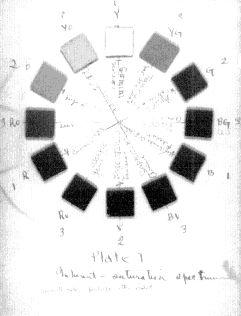
Figure 10
Stanton Macdonald-Wright, Color Wheel. Stanton
Macdonald-Wright papers, Archives of American
Art, Smithsonian Institution.
cation. Ezra Pound proposed that poets uncover the rules governing the relation between connotation and denotation in language and use this knowledge to apply standards of machine efficiency to their work. His college friend William Carlos Williams likewise described a poem as a "machine made of words," a phrase that parallels Corbusier's famous dictum that houses were machines for living in.
The emphasis on machinery reflected an optimism that knowledge led automatically to practical know-how. But first, artists had to treat their work as basic research into the components of aesthetic expression and reception. They had to isolate and specify the effects of shape, line, color, texture, perspective—all the individual elements at play in the languages particular to the various media—in experiments that isolated the elementals of perception. They needed to examine the possibilities for recombining these elementals to define more precisely the process of cognition and the translation of sensory experiences into ideas and emotions. Having uncovered laws governing experience, artists could bring forth work that surpassed representation of what already existed by actually creating experiences never before known to humanity and impossible to duplicate in any other human endeavor.
This model of the arts as an analogue to scientific investigation conforms to the conscious goals of several prominent modernist painters and critics in California. Stanton Macdonald-Wright, who moved to Los Angeles in 1918, led his students through a series of exercises that focused on the process of vision more than the craft of painting (Fig. 10). He told his students that once they had mastered the nuances of his
theories of color harmony, they could produce specific sensations for the spectator.[8] In 1935 the art critic Arthur Millier defined modern art as a poetics of scientific method when he defended the work of the postsurrealists, a group of six painters in Los Angeles and San Francisco whose work focused on the processes of cognitive association. "The characteristic creations of our time are completed in the brain before an ounce of construction material is mined," Millier began. "Ours is the age of pre-calculations so exact that their objectifications seem miraculous." To express the dominant facts of the twentieth century, art must parallel science's "precision of theory and method. It must be as precise as the intricately calculated balance of a steel bridge, as absolute in the relationship of its parts as the element of a chemical compound." The experimental method applied to the arts would reveal the workings of the mind, a claim that Millier made without any hesitation or qualifications for the postsurrealists. Yet he hesitated to erase completely all distinctions between imagination and rationality. "The artist need not be an engineer," he conceded. "But he must create poems for an engineering age."[9]
Another particularly clear expression of a scientistic view of art came from the Austrian surrealist dissident painter Wolfgang Paalen, who settled in San Francisco after World War II and became one of the key figures in the short-lived Dynaton movement. The modern movements in the arts, Paalen wrote in 1942, during the first year of his exile to the western hemisphere, had spent half a century struggling toward an "esthetic science." The roots of such a science were present in the artistic production of archaic and non-Western societies, but traditional European ideals of order and beauty had blocked true experimentation and continued to hinder the development of modern art by focusing experiments on superficial forms of spectacle.
Paalen noted that the sculptors of the Pacific Northwest peoples spoke of their work as "right" or "wrong" rather than as "beautiful" or "ugly." Such a conception, he argued, showed that art had originated as a form of problem solving that trained the mind to approach all types of problems with a vision uncluttered by preconceptions. Art, science, and religion were "inseparably interwoven with the growth and development of human intelligence."[10] In the classical European tradition, this original function of art had given way to representing decoratively the worldviews of elites. Artists who continued to work in defined representational traditions helped to maintain a decaying system of social differentiation and prestige. The end of that system and the beginnings of a more inclusive, democratic society would free artists to return to their unique and truly creative functions.
According to Paalen, the artist, as a creative person, had an ethical obligation to expand the ways open to other citizens to examine and test the world:
The true value of the image, through which artistic activity is connected with human development, lies in its capacity to project a new realization which does not have to be referred for its meaning to an object already existing. . . . [T]he true value of the artistic image does not depend upon its capacity to represent , but upon its capacity to prefigure , i.e., upon its
capacity to express potentially a new order of things. In order to distinguish between reactionary and revolutionary painting, it is enough to distinguish between what I shall call the representative image and the prefigurative image .[11]
Paalen defined the "representative image" as a realistic one that claimed to give the only significant truth of what was presented. If artists approached their subjects with clear hierarchies of values, they would produce dull work, which, however masterly its technique, would ultimately be of little use to their fellow citizens. The "prefigurative image," even if ostensibly realist, never represents what exists, "but potentially anticipates some features of what will exist . . . spontaneously answered by hints related to the most crucial preoccupation of the times."[12]
As a surrealist, Paalen groped toward a view of art as a science of the unconscious and the preconscious, but this scientistic, rationalist model of modernism does not conform at all with the romantic, largely literary view that came to dominate the discussion of modernism after 1945. The modernist canon privileges D. H. Lawrence's irrational union with the cosmos, T. S. Eliot's defense of a Christian humanist tradition, or Martin Heidegger's claim that Western philosophy took a disastrous turn with Plato. This version of modernism, however rigorous its method, denied that scientific procedure could provide any meaningful system of values. Investigation might lead to useful facts, but science provided a morally bankrupt interpretive scheme for determining what people should do with them. This form of cultural modernism corresponds to a defense of premodern, prescientific knowledge occurring when enthusiasm for the scientific method entered a field.
The antimodernists, whose views overdetermine current discussions of modernism, criticized science for artificially dividing the world into the knower and the known, the subject and the object. Antiscientific modernists believed that only the reintegration of the self into the world would dispel the horror of scientific "progress." A vision of the world was always a vision of oneself, so that humans defined their individual values, fundamental characteristics, and fate in the process of describing and therefore creating the world in which they lived.
This subject-subject view of artistic creation permeated the experimentation of the fauves, the expressionists, and the surrealists and the work of Mondrian and Klee as well as the abstract expressionist revolution of the 1940s. The same works that we can describe easily as investigations into the formal characteristics of visual communication also created autonomous worlds of pure subjectivity.
There is no single, correct interpretation of modernism that we must choose. What is more important is the view that specific creators, critics, and publics brought at given times in given places to cultural production and reception. Equally interesting is the degree to which creative people combined a scientific model with antiscientific assumptions. There was no rigid dichotomy, even in individuals. Professionalism required of
artists an attention to method as precise as that of scientists, but ultimately artists and scientists "know" the world in very different ways. A poetics of the scientific method had to come into conflict with the factors that make art a distinct human practice.
One painter who struggled with scientific and antiscientific views of art was Mabel Alvarez (Fig. 11), a founding member of the Los Angeles Modern Art Society in 1916. She believed that rigorous investigation of the effects of color could help demonstrate the actuality of "harmony." The world appeared to be in strife and to consist of opposites. She was convinced, however, that under the temporary forms of social custom was a basic order, which, if brought into daily life, would help orient people to work for moral and cultural progress. Alvarez hoped that by exploring the effects of color, her paintings showed viewers the fundamental reality of harmony. "I want to take all this beauty," she had confided to her diary in 1918, "and pour it out on canvas with such radiance that all who are lost in the darkness may feel the wonder and lift to it."[13]
In remarks similar, even if less systematic, to those propounded soon after by the Bauhaus in Germany, Alvarez noted that painting as a decorative art entered into people's daily lives. By helping to structure perceptual outlooks, paintings could reorient their viewers' relation to the world. In a diary entry from 1919, Alvarez noted that she and her sister had spent an evening discussing how to implement the principles of harmony the painter studied: "Perfect Harmony would be Heaven but we decided we would have as much as possible in everything around us and in whatever we thot [sic ] and said and did. Carmen decided to change the Disorder in her little room to Harmony, and that when we wash and put away the dishes in the kitchen we are bringing Order and Harmony out of Disorder."[14]
Moved by a memorial exhibition of Rex Slinkard's work in mid-1919, Alvarez wrote of her fellow experimental painter, who had died prematurely, that his work was "all emotion—a dream world of the spirit—Nothing of the material physical world. Strange and lovely color and compositions and subjects. He worked entirely from within and said lovely things that were all his own."[15] In Alvarez's attempt to come to grips with the sources of abstract painting, two ideas clashed: modern art sprang from inner vision and therefore was entirely individual in its form of expression, but as the work became more personal it revealed patterns of perception and cognition that correspond to universal laws working on every level of reality.
This dichotomy between the personal and the universal engaged and frustrated artists. However "experimental" they were, their work was only an imaginative re-creation of the investigatory method, not an actual scientific procedure.[16] The finished works presented viewers with irreducible, unique experiences. A successful work of art was entirely unpredictable, no matter how logical it seemed. Artists, themselves caught between the practical requirements of crafting work and the theoretical model they followed, frequently questioned the path they had chosen. Mabel Alvarez complained one evening after returning from a class with Stanton Macdonald-Wright, "I have always doubted that pure abstractions in color would be very successful judging from the way
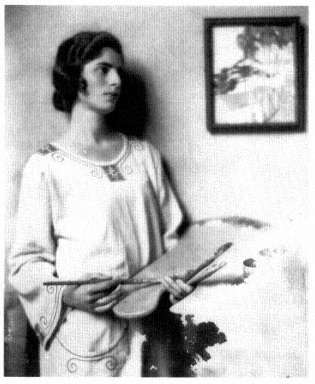
Figure 11
Mabel Alvarez, 1925. Mabel Alvarez papers,
Archives of American Art, Smithsonian Institution.
the 'moderns' have tried it. We are told we should get certain sensations from them but we don't.[17]
Modern artists could imitate the ideal of the scientist-engineer, but only by surrendering subjective freedom without gaining the objective increments of knowledge that were the source of scientific authority. The poetics of the scientific method combined opposites in a desire to discover in personal vision the necessity of universal law. Modernist goals were elusive because two contradictory ideas of power collided to leave only the tragic ashes of an aspiration. For a time, the explosion generated significant work, but eventually artists had to confront the specific nature of their power as artists and find a way of constituting the ideal artist as a type meriting the recognition and respect given the scientist. To say that a poem or a painting or a house was a machine enunciated a desire to appropriate the powers of technology and science on which contemporary social hierarchy seemed to rest. Modernism from the subjective point of view was then fundamentally a statement of desire rather than of method or epistemology. The modernist grappled with science and technology to become one of those who mastered the world and had a place of respect in it.
To understand how this aspect of the modern movement in California played itself out, I want to explore a well-known example that stretches the model of modernism as normally understood. By rethinking Sabato Rodia's Watts Towers in South-Central Los Angeles (Fig. 12) as a distinctively Californian expression of modern art, we can help to define the unique contribution of California to the modern art movement in terms that do not force us continually to define the periphery solely in its relationship to the cosmopolitan center.
Rodia was born, most likely in 1879, in Rivatoli, Italy, a peasant community twenty miles east of Naples. The family immigrated to the United States in the early 1890s and settled in central Pennsylvania, where Rodia's older brother worked as a coal miner. In his late teens Rodia moved to the West Coast, working over the years as an itinerant laborer in rock quarries and logging and railroad camps and as a construction worker and tile setter. He spoke Spanish fluently and probably lived in Mexico sometime during the first forty years of his life.
In 1921 Rodia, estranged from his wife and children, purchased a large triangular lot in the working-class community of Watts, some eight miles south of downtown Los Angeles. He immediately began to work on a large assemblage structure that he called Nuestro Pueblo, Spanish for "our town." He first built scalloped masonry walls and then constructed seven towers, the tallest nearly one hundred feet high, out of steel rods and reinforced cement. At the base of the triangle, nearest his house, he put the most parklike elements of his project: a gazebo-arbor, stalagmite groupings, fountains, birdbaths, and benches. At the narrowest point of the lot, Rodia built a galleon that he called Marco Polo's Ship. He decorated his structures with mosaics made from tile shards, broken dishes, seashells, and pieces of bottles. The walls are covered with impressions of hands, work tools, automobile parts, corncobs, wheat stalks, and various types of fruit. He incised his initials into the wet cement, as well as recurrent heart and rosette shapes.[18]
He told William Hale, who made a documentary film on the towers in 1952, "I was going to do something big, and I did."[19] His goal was to leave a monument: "You have to be good good or bad bad to be remembered."[20] His heroes were Copernicus, Galileo, and Columbus, and he felt that scientists were truly the greatest heroes, for they had changed the world more profoundly than any other group. He also told interviewers that he had started working on his project to keep himself busy after he quit drinking.
Rodia used artistic production to create a place of respect for himself, something he could do only through the exercise of imaginative freedom, for in his aspect as a laborer in an industrial society his individuality had little significance. Art gave him a way to establish his presence in the contemporary world. His project allowed him to change the world by claiming the right to narrate, and thus interpret, his own experiences and traditions. Possible folk roots for elements of his creation are the ceremonial towers of wood and ribbon used for the Festa dei Gigli (Festival of the Lilies), celebrating San Gennaro, the patron saint of his birthplace. Rodia's forms, colors, and techniques
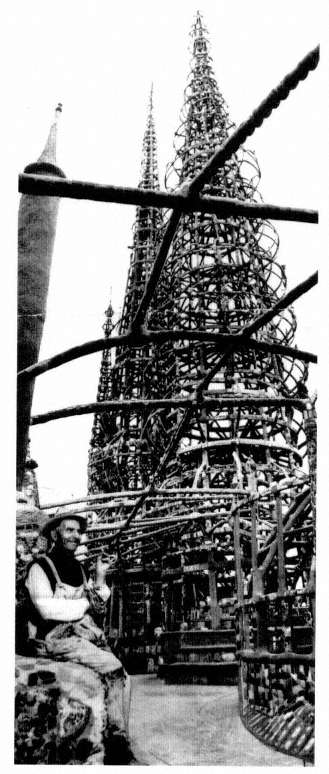
Figure 12
Sabato Rodia at his Nuestro Pueblo
(Watts Towers). Los Angeles Times photo.
however, are unique. Not a single element in the composition corresponds to traditional Italian folk art forms. Rather than nostalgically re-create memories from his early childhood, he refracted them through complex images reflecting on the rapidly changing world of the laboring immigrant.
Rodia's use of the assemblage form was key to the effect of linking past, present, and future. In assemblage, the artist uses found or constructed objects as basic materials, putting them together so that they retain some of their original identity.[21] Peter Bürger has argued that assemblage and montage are the fundamental principles of modern art: "The 'fitted' work calls attention to the fact that it is made up of reality fragments; it breaks through the appearance of totality."[22] Two corollaries follow from Bürger's argument: First, the insertion of "reality fragments" into a work of art destroys its unity and any possibility of illusion. The viewers' perceptions of the piece constantly shift between what they know was created and what was found. A sense of the work's totality emerges through the enjoyment of contradictory details rather than through appreciation of a preconceived pattern. Second, the authority of the artist's vision is undermined because the viewer sees more clearly the "constructed," arbitrary nature of the completed piece. The artist cannot claim to represent nature or to have created an alternative world. Loss of authority is compensated for by greater emphasis upon the subjectivity of the artist. The work of art is clearly an interpretation of a reality external to both creator and spectator. The aesthetic effect comes as an emotional and intellectual response to the contradictions of existence (be they individual, social, or metaphysical), rather than as a reconciliation of those contradictions in the artificial unity of an "organic" work of art.[23]
Modernist works reveal the fictional nature of representational aesthetic strategies. Nuestro Pueblo is not a town, but a set of ideas about living in industrial, urban America. Representational work helped establish a cognitive reality for members of a society by reifying its ideologies into sensory experiences that seemed lawfully necessary. Modernist works, on the other hand, helped clarify that the essential act in asserting individual autonomy in a complex society was advancing an interpretation of the apparent facts of one's life, which begin to appear more complex and ambiguous and therefore demand further investigation.[24]
Rodia's composition is a true "constructed" work because he intended the basic materials to remain visible for what they are—steel, cement, broken bottles, broken tiles, corncobs, dishes, silverware, and so forth—and the forms, while suggestive, do not insist upon a univocal reading; the towers, for example, can be viewed simultaneously as church spires, skyscrapers, garden arbor, and so forth. Rodia's own ambivalence about the specific content of individual sections of the work is indicated by the multiplicity of names and descriptions he used over the years with various interviewers.
Ernesto De Martino, a cultural historian who studied the transformation of the southern Italian peasantry over the last century, noted that when the working classes modernize, they do not throw away their traditional culture and replace it lock, stock,
and barrel with the "scientific" values of the commercial and intellectual elite. The crisis of the modern world, he argued, lies in the unresolved conflict between two distinct but interlocked modernizing worldviews, one based on power, wealth, and the monopoly of scientific knowledge, the other located in the subordinate world of work, poverty, and poor education.[25]
Modernization in both cases involves (but is not limited to) remaking earlier cultural forms into values, beliefs, and customs consistent with the facts of machinery and the increased power of the leaders of human societies. Neither was free of fear of what the future would bring, but both popular and elite cultures also wanted the benefits that increased knowledge of the world provides. The elite looked back on 2,500 years of art, literature, and philosophy to invent a tradition that made the contemporary world seem an inevitable, progressive culmination of the march of history itself. Popular culture looked back to folk arts and crafts, to ritualistic religion and magic.[26] Modern art or literature could come from either culture, but the traditions referenced were different, as were the social claims of the creative work.
We can see Nuestro Pueblo as a magical act that appropriates the powers of the modern city for Rodia and his neighbors by imitating them and transforming them into a more spiritualized form. De Martino argued that the magical process of imitation had a function more profound than the naive belief that power resides in form: "Imitation directed to an end configures itself as an additional ideological 'superimposition'" that coexists with ideological conceptions of the dominant classes.[27] Arguments over the efficacy of magic have overlooked the primary function of magic in popular culture: to provide space for ideas reflecting the integrity and self-interest of the lower classes.
Rodia's towers question and refigure the ideology, of the modern city so that it can become an imaginative home for all its residents, not just those with money. For most of the thirty-three years he lived in Watts, Rodia encouraged his neighbors to visit and use his project. Weddings and baptisms were celebrated under the towers; as festive as these uses might be, the setting nonetheless offered no escape from urban reality. Nuestro Pueblo confronts its visitors with images of the jumble of urban life: the towers reflect both church spire and the modern skyscraper and the stalagmites, both a cactus garden and apartment buildings rising up from the ground; the arbor with its incised designs speaks interchangeably of parks, the industrial worlds of automobile parts and construction tools, agricultural products, and pure purposeless beauty.
What we know about the prices of real estate, we find confirmed mythically: Nuestro Pueblo could have been created only in Watts, the Ultima Thule of Los Angeles. If Rodia had had the money to own property in more affluent sections of the city, he would have built real estate developments (or oil derricks) like Edward Doheny, the Irish immigrant teamster fortunate enough to be in the right place at the right time and become the founder of Union Oil. The towers create a reason for being there (in Watts), a metaphor that applies to human existence as well as to geography. The meta-
phor has particular pertinence to working people, whose legacies to subsequent generations are almost always anonymous. In building the towers, Rodia redeemed not only his own humanity, but also that of others like him, the poorly paid, seldom recognized working people who pass their lives in places like Watts. He showed that creativity does not depend on social privilege.
This brief look at Nuestro Pueblo as a blend of material and ideological culture returns us to the idea of Rodia's creation as a modernist exercise. An ambition to build something like Nuestro Pueblo develops only when working people can accumulate a modest amount of property and can count on leisure time to plan and execute the project. Democratic values must have spread through society so it is neither ridiculous nor dangerously presumptuous for a poor man to plan, as Rodia did, on doing "something big." Yet at the same time, social stratification based on wealth must be so all-encompassing that poor people might feel the need to assert their egos against the forces controlling the larger environment by building a microenvironment that challenges through its very idealism a world built on money. The magic of imagination challenges the magic of money (without incurring the penalties for social rebellion).
By describing Rodia's labors in mythical terms—critics have noted how Rodia worked spontaneously on the towers, almost like a beaver or a spider, without preconceived plan—we avoid considering his project as an action directed toward an end (the affirmative aspect of magic). Nuestro Pueblo is a mythic imitation of a metropolis, but it is also a psychological and social statement that affirms through its very grandeur that a human built this. To deny that statement in favor of the timeless beauty of the myth is to deny Rodia his humanity and to make him an aimless wanderer on the edges of our society, of it but not to be integrated into it. It is in this sense that De Martino defined the magical act as a constant attempt to declare one's humanity so as to achieve a recognizable place in the world: "In reality, the problem of magic is not one of 'understanding' or of 'modifying' the world, but above all of guaranteeing a world in which a being can become present." Magic is a form for asserting the "transcendental unity of self-consciousness"[28] in the face of a world based on social fragmentation and competition. But in modern societies, the tools and conditions for self-expression become more powerful and are in effect democratized, even if they coexist with a hierarchy of prestige and status.
An aesthetics of magic and an aesthetics of scientism were two phases of the same phenomenon, as the modernist fascination with the tarot, Kabbalah, I Ching, Tao, and all forms of mythology attests. For most people science and magic work in unknown, mysterious ways but provide cognitive maps; their prestige is based on their apparent power to predict results. The working methodology of scientific procedure is so different from aesthetic process that the effort of modern artists to appropriate the powers of science functioned as a form of magic, deployed to seize power by narratively redefining the artist's place and function in society. Modernist exploration in the visual arts recreated in a new framework the powers of the modern era, but the effort left unspecified the practical contributions artists hoped to offer their fellow citizens.
For all the powers that science demonstrated throughout the nineteenth century and has continued to demonstrate with even greater effectiveness through the twentieth, there is a fundamental contradiction in the expansion of scientific process in social life, a split that tends to produce a fragmentation of identity and a virtual schizophrenia. In the area of practical contribution to social life, the individual voluntarily becomes the slave of the requirements of the system of purposive rational action. Desired results flow by following predetermined procedures. Yet the expanded powers of science and technology provide increasing numbers of people with the means to pursue their fantasies unhampered by the inefficiencies of pretechnological organization and distribution. Desire in the area of consumption could find more direct satisfaction. Nathaniel Hawthorne, in an extraordinarily perceptive phrase, recognized this interiorizing aspect of the machine age in 1851 when he had a character in The House of the Seven Gables make the at first astonishing claim, "Trains are the spiritualization of travel!"[29]
Science and the machine age had expanded and problematized the question of freedom. The Declaration of Independence and the United States Constitution enshrined the classical idea that freedom devolved from the ability of free-holding individuals to participate in political decisions affecting their communities; this idea was now transformed into an existential question: how might inhabitants of a structured society both achieve practical goals and explore the possibilities inherent in personal fantasies? The scientific method offered no help in answering this question, but religion and humanism did, even if their answers had developed in societies with more rigid limitations on the potential of human action.
The dangers that scientific knowledge posed for humanity became inescapable for Europeans in 1914. Rational organization in the service of equally brutal autocrats and democrats led to the largest bloodbath in history. The frenetic enthusiasm of the futurists and the cheerfully optimistic experiments of the cubists and fauves did not survive the war. After 1918 new European avant-gardes, such as the surrealists and expressionists, looked for alternatives to rationality to give vent to their fear that the continued primacy of reasonable men would lead to even greater horrors. Americans retreated into isolation and maintained, despite social problems, the hope that the liberation of individual creativity would lead to a better world. The depression of the 1930s undermined that confidence, but Americans did not truly confront the ambiguities of progress until 1945, when the blood guilt of Hiroshima and Nagasaki and the revelation of the olocaust proved that technology served evil as readily as good. As in Europe twenty-five years earlier, the shock of war opened the gates to a mistrust of rationality. In the changed postwar environment a new vital role for the arts appeared. Art stood, not as an icon for the necessity of personal vision, but as a process that symbolized the freedom of the unique and the irrational. This transformation required little stylistic change, simply a realignment of interpretive value. Instead of casting investigations of visual experience as cognitive experiments, artists found in their work proof of an interior reality that persisted despite external conditions.
Perry Anderson has argued that the critical synthesis of avant-garde cultural move-
ments into a unity marked by the term modernism occurred only after 1945, when the basic impetus of those movements was already moribund. He concluded that modernism as a concept involves an inherent sense of nostalgia for a classic age one has missed.[30] The word "modernism" entered the culture of the post-World War II era as a ghost that haunts those who have followed because it speaks of a classic age of creativity, one equal to the Renaissance in the scope, vitality, and fluidity of the work produced. The greatness of this work springs from the determination of men and women of this period to come to grips with the challenge of science and create a place for themselves in a new world ceaselessly flowing into being. Modernism has been an elusive, muddled concept because it could have no set meaning. The responses to the simultaneous expansion of knowledge and imagination varied across time, place, and position.
As Rodia's work suggests, the challenge of modern life in California was considerably different from that in much of the rest of the world. The Second World War hastened the state's transformation from a provincial society into a metropolitan center. Cold war military spending brought prosperity, and the state's population boom created a new middle class, most of them migrants to the state, many of them young men and women from lower-income backgrounds who benefited from the new opportunities modern society seemed to provide. Freed from limiting if identity-giving geographic, family, and class roots, many during the postwar boom had to create their own lives in a complex world that was often indifferent, if not openly hostile or derisive. The ultimate universal that the arts in California proposed was the ability of each individual to define the meaning of his or her own existence in the relative isolation a new society provided.
Isolated from, but not ignorant of, the main developments of world culture, California's modern artists and poets provided a model for a creative synthesis that could lead to a new contemporary culture transcending modernism. The California modern movement had been so removed geographically, if not in time, from the social problematics of European modernism that men and women interested in European cultural debates in the 1920s and 1930s had already constituted modernism as a whole for themselves. The painter Lorser Feitelson declared himself both surrealist and futurist, even though he knew the movements were antagonistic, in order to create for himself what he considered the essence of the modern approach to art. The critic Lawrence Hart "deconstructed" the work of Eliot, Pound, and the French surrealists into a theory of poetry he called activism. We can view these experiments as evidence of a provincial pseudo-surrealism irrelevant to the "main line" of avant-garde thought, but such a judgment would naively accept the modernist assumption that art was in fact the source of universal, ahistorical truths.
The work California's moderns created often spoke wistfully of dreams to maintain the delicate balance between individuality and membership in a powerful, often anonymous and overpowering, social organization. In 1947, after winning first prize in the
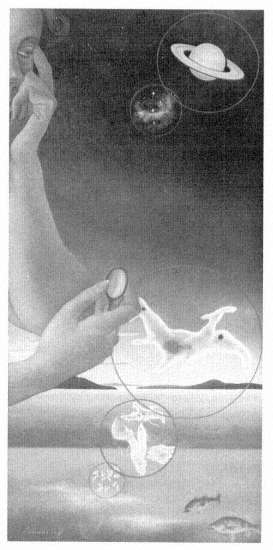
Figure 13
Helen Lundeberg, Microcosm and Macrocosm ,
1937. Oil on Masonite, 28½ × 14 m. Private collec-
tion. Photograph courtesy Tobey C. Moss Gallery
Los Angeles.
annual Los Angeles County Museum art show, Helen Lundeberg (Fig. 13) received a letter from an admirer, who wrote that she saw in Lundeberg's paintings
a sense of humility as well as awe before the majesty of things. There is also, or so it seems to me, an acceptance of the solitariness of the individual in your work. . . . A togetherness between two people is an impossibility, and where it seems nevertheless to exist—it robs either one or both of his fullest freedom of development but once the realization is accepted that even between the closest of human beings infinite distances continue to exist, a wonderful living side by side can grow up.[31]
The powers that created the modern world augmented and diminished the individual. The poetics of the experimental method ebbed into a celebration of what the lone individual felt. Elegy often marks the transitional work at the end of high modernism, for freedom was achieved by giving up faith in a technological utopia. When modernism passed, the scientific method and engineering were firmly at the heart of the contemporary world, so firmly that the public needed a counterweight. The artist in the post—World War II period then could shed the costume of scientific investigator uncovering universal law and appear as the figure defending desire, imagination, and irrationality in a world shaped by science. As became evident by mid-century, artifice for the sake of pleasure alone could claim to be every bit as important as the accumulation of knowledge. With that transformation, the quest to be modern could end, for the separation from the ancients and from the sacred stability of tradition was complete.
Painting Under the Shadow:
California Modernism and the Second World War
Susan Landauer
The Scenario of Chaos
Modernism, as Malcolm Bradbury and James McFarlane tell us, is born of "cataclysmic upheavals of culture, those fundamental convulsions of the creative human spirit. . . . It is the one [artistic impulse] that responds to the scenario of our chaos."[1] Behind these words is an understanding that war is among the defining themes of modernism in Europe and America. Despite Virginia Woolf's oft-quoted line about the world changing in 1910, it was the First World War that proved such a great catalyst for modernism across the arts. The explosion of modernism—whether the dada performances in Zurich, the poetry of T. S. Eliot, the drawings of George Grosz, or the plays of Bertolt Brecht—was clearly a response to the war, even when artists abandoned the themes of battle and violence for those related to social structure or the human psyche. Perhaps because of the immense jolt of the First World War, the modernist burst after World War II was less intense than that of the teens and twenties. But this second surge of modernism was indeed significant, bringing us the introspection of French existentialism, the nightmare visions of Francis Bacon, and the absurdist plays of Samuel Beckett.
In California, however, the sequence of events was reversed. In contrast to the European capitals or New York, the modernist explosion after the Second World War was far more extensive than that following the First. As the essays in this volume attest, there were pockets of modernist activity in California well before the 1940s. But the number of modernists was small by comparison to that in New York, where precision-ism dominated the artistic discourse of the 1920s and where abstractionists such as Stuart Davis could thrive even during the aesthetically conservative 1930s. For California, it took World War II to initiate the first great burst of modernism. The catalyst was not only the horror of the war, but also the explosive transformation of the state. More than half of all army cargo and troops bound for the Pacific theater passed through San Francisco's Golden "Victory" Gate.[2] In the space of a few years, several million people moved to the West Coast to work in the country's largest centers of shipbuilding
and aircraft construction—mostly in and around San Francisco and Los Angeles. By the late 1940s the San Francisco Chronicle was boasting that the massive westward migration "dwarfs the crusades and makes the Gold Rush seem like a boy scout outing."[3]
Mirroring these sweeping demographic changes, California's artistic community grew as the war brought artists—returning veterans—from all parts of the country, many arriving through the ports of Los Angeles and San Francisco. In addition, with the influx of refugees from fascism came European avant-garde ideas. Although New York was the center for European artists in exile during the war, Los Angeles drew a sizable number of artists, writers, musicians, and composers, including Thomas Mann, Bertolt Brecht, Arnold Schoenberg, Salvador Dalí, Man Ray, and Igor Stravinsky.[4] San Francisco attracted fewer émigrés than Los Angeles, but artists such as Stanley William Hayter, Gordon Onslow-Ford, Wolfgang Paalen, Jean Varda, and Max Beckmann—and returning expatriates like Charles Howard and Henry Miller—helped to expand the cultural horizons of the state.
Also adding to California's newfound cosmopolitanism was the wartime museum policy of circulating exhibitions of contemporary painting from coast to coast—initi-ated in part to offset the removal of art treasures inland for safekeeping. The director of the San Francisco Museum of Art, Grace McCann Morley, embraced the policy enthusiastically. Morley's exhibitions, many of them loan shows from the Museum of Modern Art in New York, brought to Bay Area audiences the latest work of Max Ernst, Roberto Matta, André Masson, Yves Tanguy, Pier Mondrian, and many other European émigrés then in New York. Indeed, the first major survey to include contemporary painting by European refugees in America, Abstract and Surrealist Art in the United States , was organized by Morley with the help of the New York art dealer Sidney Janis in 1944 for travel on the West Coast. The exhibition featured, among others, the little-known painters Mark Rothko, Arshile Gorky, Robert Motherwell, and Jackson Pollock.
The impact of all this activity was immediate and profound. By the end of the war, California artists found themselves at work in national and international contexts that pulled them out of their provincial preoccupations and toward broader worldviews. Although in 1939 the critic Alfred Frankenstein observed a nearly exclusive focus on "the more or less objective recording of native themes and situations,"[5] by the war's close in 1945 the Montgomery Street Skylight was reporting "a mass conversion to abstraction," even among "veterans of the picturesque flowerpot."[6] The forms California modernism took reflected more or less those found elsewhere in the country: surrealism, abstraction, and expressionism, fusing toward the end of the forties in the movement known variously in San Francisco as "free-form," "first sensation," and, in less sympathetic quarters, the "drip and drool school." Abstract expressionism was slower to attract adherents in Southern California. While San Francisco's most forceful presence was Clyfford Still, Los Angeles's modernism was dominated by the hard-edge abstraction of Lorser Feitelson and John McLaughlin and the tempestuous figuration of Rico Lebrun.
As different as their aesthetics may have been, these artists shared a double-hermed response to the war. On the one hand, their embrace of modernism was itself a turning outward, a manifestation of a new global perspective that deemed regionalism irrelevant. Modernism, as the cultural lingua franca of the free world, represented a repudiation of totalitarianism and its brutal curtailment of artistic expression. At the same time, this modernism—and herein lies its most significant departure from the machine aesthetic of much post-World War I art in America—was deeply inner-directed. Expressionists, surrealists, and abstractionists alike responded to the ferment by turning inward, away from social and political reality, to the realm of individual imagination. It is in part an index of their revulsion from the mass destruction made possible by modern industry and technology that so many modernists in California, like their counterparts elsewhere in the country, concentrated on such un-modern phenomena as dreams, myth, and magic. The depth and breadth of this primitivist impulse can be measured by its grip on such relatively conservative painters as Matthew Barnes. The tendency cut across political and aesthetic lines.
Despite such pervasive subjectivism, many California modernists wanted to contribute to the war effort. The Works Progress Administration (WPA) Southern California Art Project, until it closed in 1942., hired artists to paint murals for troops in training—to produce "fighting art to inspire fighting soldiers," in the words of Feitelson, the project's design supervisor.[7] Most modernists, however, drew the line at creating propaganda for the Office of War Information (despite tempting offers of employment), letting more traditional artists and Hollywood filmmakers take on the work of boosting homefront morale. Their view conformed with Duncan Phillips's in his classic mandarin exhortation not to press art into the service of any social, political, or religious idea, since "art is a social communication and a national asset, but never more so than when it is a miracle of personal expression."[8]
The majority of California modernists were thus content to express their subjective responses rather than comment overtly on the conflict. Most registered the impact of the war through dramatic changes in the content or style of their work. There is little in the San Francisco Museum of Art's painting and sculpture annual of 1941 to suggest that a global conflagration was taking place. A year later, however, Robert Howard and Adaline Kent were alluding to the war through titles such as Combat and Victory . Palettes also darkened to suggest a gloomy despondency. Artists of various aesthetic persuasions, from Ruth Armer to Hans Burkhardt, expressed the prevailing atmosphere of dread by painting in deep reds and blacks. This color combination, a favorite of Still's, became a mainstay for Bay Area abstract expressionists well into the 1950s.
Another, more familiar, modernist strategy for expressing the mood of the period was through compositional fragmentation. This approach can be found in the twisted automobile carcasses of Howard Warshaw (Fig. 14), the decomposing anatomies of Lebrun, and the colliding razor-edged shards of Feitelson, each expressing the flux, instability, and dislocation of the period.
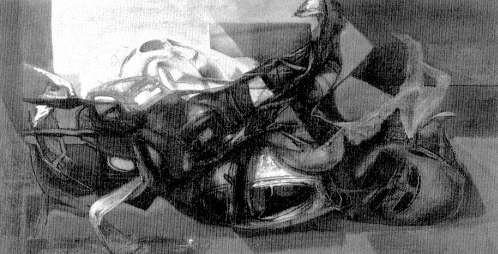
Figure 14
Howard Warshaw, Wrecked Automobiles , 1949. Gouache on canvas, 23 × 47 in.
Los Angeles County Museum of Art, Los Angeles County Funds.
At the other extreme, but just as much a response to the upheaval, were the meticulously controlled abstractions of James McCray, Frederick Hammersley, and Peter Krasnow. Krasnow's work in particular demonstrates what Austin Warren called the "rage for order," the urge to impose some measure of control on a chaotic world (see Plate 4).[9] Krasnow's perfectly axial bricks of radiant color were intended as a soothing balm in turbulent times: "When tragedy was at the deepest point," he later said, "my paintings breathed joy and light—color structure instead of battle scenes, symmetry to repair broken worlds."[10]
The painting of John McLaughlin presents an interesting bridge between these opposing strategies for dealing with the trauma of the war and its aftermath. While at first glance the neat contours and streamlined surfaces of McLaughlin's geometric abstractions communicate a universe of order and stability, their ambiguous spatial relationships effectively undermine the initial impression of harmony. Although Susan Larsen's interpretation of McLaughlin's abstractions as profoundly anticlassical may be an overstatement, these works do provide a subtle commentary on the psychological climate of the era.[11]
Most California modernists approached the theme of war iconographically rather than through such oblique indices of style. Following Rufino Tamayo's lead, they depicted beasts locked in battle to convey the savagery of military aggression or, like Ernst painted ruins crumbling under relentless vegetation to suggest civilization's moral decay
It is interesting to see how closely realists and abstractionists converged thematically during the 1940s. Both were consumed with allegories of strife and despair, differing primarily in their degree of literalism.
Amid the passion and suffering of the war, it is not surprising that the crucifix became a common metaphor, treated by figurative and abstract painters alike. Lebrun's ambitious Crucifix cycle (1947- 50), comprising over two hundred drawings and a large triptych, is perhaps the best-known example, but Burkhardt and Eugene Berman also treated the subject. Their paintings are among the few modernist attempts to bestow a measure of nobility on those who fought and suffered in the war. As an emblem of the soldier's heroic sacrifice, the crucifix had been invoked in the war poetry of Siegfried Sassoon, Wilfred Owen, and Randall Jarrell. The historian Paul Fussell has traced the image to the trenches of World War I, where rumors circulated about Germans' crucifying captured soldiers, rumors the press sensationalized to rally public support for the war. A crucifix incident at the front lines during World War II also made its way into American newspapers—testimony to the power of the image.[12] As general a part of the culture as the crucifix is, Frank Lobdell's later ascending spread-eagles—which also suggest the Resurrection—probably had their source in the wartime adoption of religious allegory.
Although modernists in California expressed their emotional reactions to the war, and in some cases dealt with the moral, psychological, and physical costs of the conflict, the indirection and nonspecificity of their work generally took the political bite out of it. The Second World War provoked few overt protests or attacks on society, and certainly nothing as combative as the angry denunciations of the dadaists or the Weimar expressionists. Curiously, one of the most scathing condemnations of World War II came not from the liberal modernist quarter, as one might expect, but from the conservative Midwest regionalist Thomas Hart Benton.[13] Benton's murals of burning farms and soldiers blown to pieces stirred up far more controversy than such noncommittal paintings as Charles Howard's First War Winter (1939-40). Howard's painting carries no more political freight than a December rainstorm by the realist Millard Sheets. Not until the mid-1950s, with the rise of Bay Area funk art, would California modernists in significant numbers become conspicuously political in their art.
In fact there was little clear-cut opposition to the war among modernists anywhere in the country until after it had ended and the mind-bending human toll from the death camps and atomic explosions was tabulated. Although the overwhelming majority of modernists in California harbored pacifist sentiments, most believed, like the American population as a whole, in the necessity of U.S. involvement in this particular war. Such support did not dampen the agony and horror so many California modernists incorporated into their art. But the war engendered greatly varied artistic expressions, from the highly aestheticized anger of Burkhardt to the whimsical escapism of Clay Spohn's War Machines and the ominous impastoed canvases of many San Francisco abstract expressionists.
Disarming Parables: Hans Burkhardt's War Paintings
Hans Burkhardt stands apart among modernists in California, not only for his opposition to World War II at its very outset, but also for his willingness to confront political reality directly in his art. Burkhardt's more than forty antiwar paintings, begun several years before America entered the conflict, were virtually the only modernist protests in California. Paintings such as One Way Road (1945), with its imagery of limitless, incalculable destruction, or Iwo Jima (1945), with its bloody mutilation, contrasted dramatically with the popular media's sanitized portrayal of the war in the 1940s, when even novelists were admonished not to write of combat as an unpleasant affair.[14] Burkhardt's works were intended to jolt viewers out of their apathy, and indeed, they sometimes provoked heated reactions. Even his War, Agony in Death (1939-40; Fig. 15), which condemned the German bombing of the Basque town of Guernica, inflamed Los Angeles viewers in 1944. One woman attacked it with a cane and had to be forcibly removed from a gallery on Sunset Boulevard.
Burkhardt spent the late 1920s and 1930s receiving private tutorials from Arshile Gorky in New York, where, along with Gorky's other informal pupil, Willem de Kooning, he developed a relatively sophisticated understanding of French abstraction from Cézanne to Miró. Burkhardt's thematic concerns, however, soon diverged from those of de Kooning and Gorky, both of whom kept their distance from the political arena. As early as 1937, after Burkhardt had moved to Los Angeles, his work began to reflect the growing turmoil in Europe. In 1938 he initiated a series of canvases on the theme of the Spanish Civil War, culminating in War, Agony in Death , the first of his mural-sized antiwar paintings. Burkhardt claimed to have been unaware of Picasso's Guernica , and indeed, the final product synthesizes expressionist and surrealist styles in a very un-Picasso-like manner, with slashing brushwork and a palette of lurid reds reminiscent of Chaim Soutine's. Unlike Picasso, Burkhardt does not attempt to evoke the actual bombardment but presents a generalized image of devastation. Although the painting is dominated by a back-thrust head with mouth open wide that recalls Picasso's shrieking figures as well as such earlier antecedents as Hieronymus Bosch's gaping jaws of hell, Burkhardt's head is less easily identified. Half-human, half-armored tank, its twisted, dripping mouth emits a cry that powerfully expresses the collective anguish of Guernica. The destruction of life is indicated by the profusion of crosses—so numerous that the), topple over one another in competition for space, an allusion perhaps to the mass graves that were then a largely unpublicized fact of war.
Burkhardt's knowledge of collective graves could not have come from firsthand combat experience. Beyond the draft age, he had spent the early part of World War II in a Southern California defense plant building airplane parts and the remainder finishing furniture for a film studio in Hollywood. His closest personal contact with war waobserving, as a child in Switzerland, the eerie red glow produced by bombs bursting. over the border mountains during World War I. This image is often conjured in his paintings,[15] but the crimson sky as a backdrop for battle has a long tradition in poetry
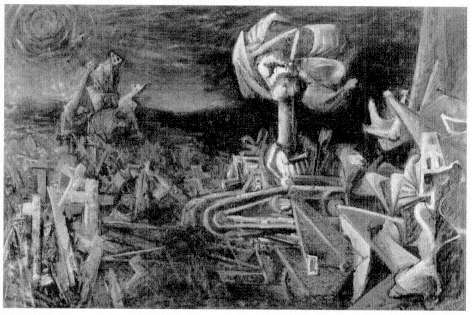
Figure 15
Hans Burkhardt, War, Agony in Death , 1939-40.
Oil on canvas, 78 × 114 in. California State University at Northridge.
Photograph courtesy Jack Rutberg Fine Arts, Los Angeles.
and painting, from Eugene Delacroix to Edmund Blunden.[16] For the most part, then, Burkhardt's vision of war drew primarily on his imagination, as well as cumulative associations from literature, the popular media, and the work of other artists. His work is best understood, not as an expression of the "reality" of war, but as a response to antecedent, technique, actual events, and, above all, his own intense feelings about the destruction and violence of war.[17]
Burkhardt's antipathy cannot be traced to any involvement with organized religion or politics; his preoccupation with death and suffering had much more personal roots. He spent his early childhood in Basel's industrial quarter, where his family's home stood in the shadow of a chemical factory and across the street from a rat-infested junkyard.[18] When Burkhardt was three, his father abandoned the family for America; a few years later, when his mother died of tuberculosis, he and his sister went to live in an orphanage. Years later, after moving to New York to join his father and stepmother, he lost both within a year, one to illness and the other to an automobile accident.
The theme of abandonment can be found in one of Burkhardt's first war paintings, The Parting (1939; Fig. 16). Although highly abstract, the image can be read as a man leaving his family to go to war. On the left, several children cry out, while on the right, their parents embrace for a final parting kiss.[19] This painting provides a template for
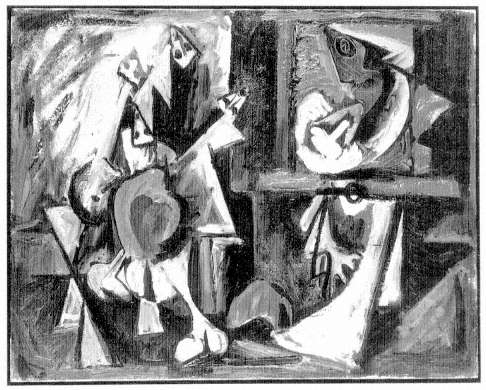
Figure 16
Hans Burkhardt, The Parting , 1939. Oil on canvas, 22 × 28 in
Photograph courtesy Jack Rutberg Fine Arts, Los Angeles
many of Burkhardt's later works, notably War, Agony in Death , where the "children" reappear as a personal shorthand for suffering. But there the "father-mother" configuration has metamorphosed into a monstrous weapon of war. The image projects Burkhardt's conflicted feelings of anger and loss toward his parents while doubling as a metaphor for the demonic forces of technology. On both levels of parable, victim and oppressor are conflated.
Burkhardt has been described as Goya's spiritual heir, and it is true that few artists since Goya have been as consumed by the brutality of war. But unlike Goya's Disasters of War (1810), Burkhardt's paintings dwell on the innocent victims rather than those responsible for war's atrocities.[20] Among his most horrific renderings of suffering are the concentration camp paintings, of which he made at least four during the course of the war. The first, painted in 1941, suggests two skeletal figures locked in an embrace. The threat of death is near, symbolized by two crosses at their heads. By 1942, the figures have collapsed into an undifferentiated heap, with only the most tentative characteristics of humanity to define them. Burkhardt unleashes some of his most savage
brushwork in this painting and its companion of the same year, with ragged, slashing strokes that express the full force of his fury. These paintings, however, are most remarkable, not for their emotional intensity, but for their prophetic imaging. Although it was common knowledge in America at the time that the Nazis had confined European Jews to concentration camps, the details of Hitler's gas chambers and crematoria were made public only in 1943. Even in 1944 most Americans remained oblivious to the genocide. According to the historian John Morton Blum, a poll taken in December 1944 revealed that much of the general public "knew Hitler had killed some Jews but could not believe that even the Nazis had methodically murdered millions."[21]
Skeletal forms appear in Burkhardt's paintings with increasing frequency toward the end of the war, culminating in one of his most harrowing paintings, VE Day (1945; Plate 5). The subject of victory in Europe might suggest something celebratory, but Burkhardt confronts the appalling cost of the armistice by presenting a panorama of horror that recalls the hellscapes of Bosch. The dead and wounded are shown in such profusion that they appear to rise ad infinitum beyond the canvas. In some cases, their bodies appear torn and mutilated. One disembodied member actually appears to pierce another, causing a cascade of blood. This painting, however, constitutes one of the rare instances in which Burkhardt specifies the gruesome details of war. Although he often implies an abundance of blood through a liberal use of red, Burkhardt largely excludes the horror of battle from his paintings. Nowhere do we find the rotting maggot-infested cadavers of Otto Dix, who painted the German battlefields of World War I. Compared with Dix's nauseating body-littered trenches, Burkhardt's VE Day provides a pleasure to the eye.
It is a paradox of Burkhardt's work—and indeed, of many modernist attempts to treat the theme of war—that a concern with technique often resulted in the artful rendering of a profoundly ugly subject. Many of Burkhardt's paintings present an unsettling conjunction of sensuality and death. Burkhardt certainly did not intend to aestheticize violence or to use his war paintings as vehicles for virtuosity, but that is precisely what he did. His paintings of atomic explosions, with their radiant colors and masterful handling of line, are especially dazzling.
Burkhardt embraced not only the aesthetic devotion of modernism but also its aversion to narrative, which precluded the concrete treatment of war found in the work of Dix or Goya. Although his paintings are for the most part tied to specific events, they show some of the same striving for universality that one finds in abstract expressionism. In most of Burkhardt's paintings, people appear, not as individuals, but as archetypes of humanity. Burkhardt shared abstract expressionism's ambition to express a content generic to all cultures, to speak what Elmer Bischoff called a pictorial Esperanto.[22]
Burkhardt's desire for unity, the flip side of his obsession with war, could at times verge on utopianism, as in One World (1945), a painting that exceeds even the idealism of Wendell Willkie's best-selling book of the same title published two years earlier. Going well beyond Willkie's call for global democracy, Burkhardt imagines a world in
which all the races have blended to form a single unified culture, symbolized by an abstraction of interlocking planes of color. A strain of optimism runs through much of Burkhardt's work. Many of his darkest war paintings of the 1940s contain a glimmer of hope, often suggested by the conventional landscape allegory of storm clouds beginning to break. Occasionally, Burkhardt's paintings serve as an arena for enacting his fantasies of political justice. As early as 1939 he painted Hitler hanging from a noose over the ruins of Germany. In later decades he would bury Lyndon Johnson for his complicity in the Vietnam War and Richard Nixon for his corruption of the government. But if Burkhardt occasionally found imaginative release through his art, the seriousness of political injustice was never far from his mind. His brand of escapism was not intended for amusement or diversion. Burkhardt's sober response to World War II was worlds apart from Clay Spohn's whimsical flights of fantasy.
Clay Spohn's Fantastic War Machines
In the summer of 1941, some six months before the bombing of Pearl Harbor, the San Francisco artist Clay Spohn began having recurring dreams about battling the Axis powers with fantastic weapons of war. "They were not nightmares," he recalled, "but like great spectacles of color."[23] Spohn took profuse notes on these dreams, waking in the middle of the night to make elaborate annotated "obsession drawings." Most of his more than two hundred ideas for war-related paintings never evolved beyond scrap paper, but at the urging of his good friend Charles Howard, Spohn produced enough finished works for an exhibition. A notorious procrastinator, Spohn worked on them until the very eve of their presentation. On February 22, 1942, two months after America entered the Second World War, Spohn's Fantastic War Machines and Guerragraphs premiered at the San Francisco Museum of Art.
The critical reaction to Spohn's exhibition was alternately baffled and bemused. It was difficult to say whether the artist was ridiculing the war effort or merely indulging in escapist fantasy. The show consisted of nine meticulously drawn, elaborately captioned gouache renderings of weaponry, which, as one critic quipped, illustrated some very unorthodox ways of winning the war.[24]Hover Machine (Fig. 17), for example, showed a device that could snare enemy vessels from both sea and air at lightning speed with the grappling hooks it ejected on cables from lubricated windlasses. Tornado Machine depicted an electronically controlled cyclone; Spy Detector showed an ornately decorated vehicle with outsize spy glasses; Balloonic Uplifters represented brassiere-shaped nets to entrap enemy aircraft; and the mammoth Rolling Fort (Fig. 18) featured
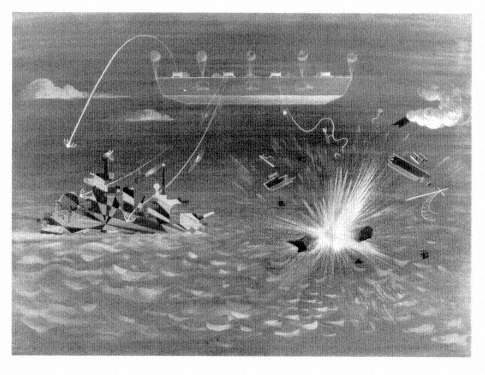
Figure 17
Clay Spohn, Hover Machine , 1942. Gouache on paper, 15 × 20 in. The Oakland
Museum, gift of the Estate of Peggy, Nelson Dixon. Photograph by M. Lee Fatherree.
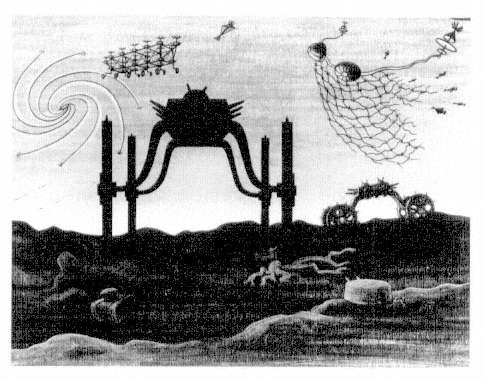
Figure 18
Clay Spohn, The Rolling Fort , 1942. Watercolor on matboard, 18¾ × 26 1/8 in.
Nora Eccles Harrison Museum of Art, Utah State University, Logan, Utah.
Gift of the Marie Eccles Caine Foundation.
a chassis one hundred and twenty feet above the ground. Spohn's exhibition also included eleven drawings and gouaches of various war-related subjects, for which Douglas MacAgy, the show's curator, coined the term Guerragraph , from the Spanish word for war. At least one of the Guerragraphs anticipated the "Spy vs. Spy" cartoons of Mad Magazine , showing spies engaged in various ludicrous operations, such as peering at each other from around the corners of buildings and from other conspicuous hiding places.[25]
Spohn's War Machines and Guerragraphs have often been classified as surrealist, and indeed, Spohn borrowed liberally from that movement.[26] Stylistically, his approach was closest to that of René Magritte, Dalí, and Tanguy, who sought to fix dream-inspired images by illusionistic means. Spohn's work resembles that of these artists in its crisp delineation and smooth, unmodulated colors as well as in the artist's tendency, particularly in the Guerragraphs , to suspend forms weightlessly in a dreamlike landscape (Fig. 19). But Spohn's variety of madcap comedy is unusual in surrealism. His playful antics seem blissfully naive compared with the black humor of Magritte or Dalí. When the Europeans dealt explicitly with the subject of war, there was little lighthearted humor. Magritte's Black Flag (1937), for example, makes a striking contrast with Spohn's renditions. Magritte's war machines are equally fantastic and irrational, but their dark silhouettes are ominous and funereal. Hovering above a colorless landscape depleted of life, they could be, as Sidra Stich has suggested, the futuristic relics of a dead civilization.[27] Spohn was less concerned with the sinister implications of war, in large part because he did not subscribe to surrealism's Freudian view of humanity as inherently barbaric. Spohn preferred to focus on the positive elements of human nature, and he did not share the surrealist ambition to discommode the social status quo by revealing the dark and unruly workings of the mind. If, like the surrealists, Spohn hoped to short-circuit the intellect through humor and fantasy, it was rather to intensify the pleasure of life.[28]
In this sense, Spohn's approach was closer to Alexander Calder's than to that of any of the surrealists. Calder's whimsical mechanical sculptures may in fact have been an important stimulus for Spohn, since the two artists had known each other since their days at the Art Students League in New York and had worked in adjacent studios in Paris during the 1920s. It was apparently Spohn whose suggestion that Calder work with wire ultimately led him to invent the mobile.[29] Spohn's colorful kites and streamers and his kinetic Wind Machine for San Francisco's Open Air Show in 1941 were very much in the spirit of Calder's fanciful mobiles and circus toys.
Yet Spohn's War Machines were perhaps closer still to the preposterous contraptions of Rube Goldberg, then a popular cartoonist for the New York Evening Sun . Goldberg's mural Automatic Hitler Kicking Machine (1942) was as filled with impossible gadgetry as Spohn's inventions.[30] It would hardly be surprising if Spohn had admired Goldberg. since Spohn had also begun as a cartoonist.[31] Although he quickly abandoned cartoon work to pursue a career in painting, he continued to amuse himself and others with his
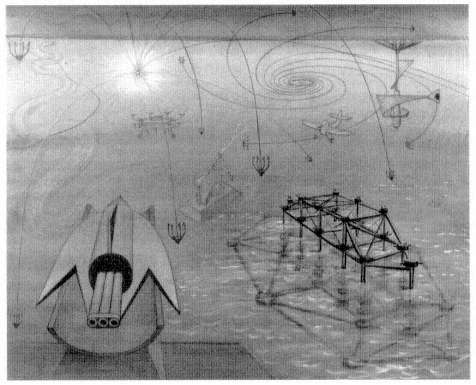
Figure 19
Clay Spohn, The Unsinkable Fort , 1942. Gouache, pencil, and crayon on paper,
17 ¾ × 21 in. Collection of John E Axelrod, Boston. Photograph by Michael Korol.
considerable comedic talent. Spohn was acclaimed in San Francisco in the 1940s particularly for his zany assemblages—the best known being his Museum of Unknown and Little-Known Objects (1949), which featured such whimsical exhibits as Bedroom Fluff , a collection of dust balls Spohn gathered from under a friend's bed; Old Embryo, a rubber Halloween mask floating eerily in a chemist's flask; and Mouse Seeds , a jar of mildewed rice. Spohn described these creations as "prankisms," acknowledging that they lacked the intellectual underpinnings of dada or surrealism.[32] Like many American modernists, Spohn approached art instinctually rather than theoretically.[33] Indeed, he was attracted to humor precisely because it afforded "a kind of free release from the bondage of dogma."[34]
The moment when Spohn's Fantastic War Machines debuted at the San Francisco Museum of Art could hardly have been more tense. In early 1942 the Japanese were rapidly overpowering the small, ill-equipped American garrisons on Pacific islands. The
fall of Bataan in the first few months of 1942 was probably the nadir of the war for the Allies, coming shortly after the loss of Singapore and Hong Kong and the sinking of the great British battleships the Prince of Wales and the Repulse .[35] Although most San Franciscans experienced these events only in news reports, the war was difficult to forget with such daily reminders as the convoys of warships filing steadily through the Golden Gate, with Angel Island overflowing with German and Japanese prisoners of war, and with such strange sights as the enormous Kaiser Shipyards, so busy producing Liberty ships that, as Dos Passos reported, they glowed all night long like forest fires.[36] Not only was San Francisco the major supply port for troops and munitions fueling the war effort, but it was also America's lifeline. The daily plasma drives and Red Cross blood banks springing up in such places as the California School of Fine Arts on Russian Hill were a grisly reminder that a massive war was on.
The anxiety was particularly acute in the months just after the bombing of Pearl Harbor. As the most strategically important port in the country, and hence America's front line, San Francisco was consumed by fear of becoming the next target. Blackouts were nightly events, and posters around the city warned civilians and soldiers alike to "zip your lip" since "loose lips sink ships." The paranoia can be measured by the rumors that filled the local newspapers. One story accused Japanese-born farmers of planting their tomatoes in the shape of an arrow to guide enemy bombers.[37] Another claimed that the Italian residents of North Beach were protecting their homes from air attack by painting swastikas on their roofs.[38]
Spohn's humorous spies and fantastic weaponry thus clearly ministered to a desperate need to relieve the tension.[39] Yet while Spohn certainly intended that the War Machines and Guerragraphs amuse, he also meant them as provocative satire. As Spohn's biographer, David Beasley, has written, these paintings "mocked imaginatively their original unworkableness as much as they mocked the seriousness of war."[40] They suggested the fiction of the government's and the media's grandiose claims that American weapons were invincible. The critic who described Spohn's War Machines as "Popular Science gone nuts"[41] had clearly not picked up a recent issue of the magazine, or he would have known that Spohn's ideas were not so distant from some of the armament designs seriously proposed at the start of the war, such as John Hodgdon's "Gyroscope Torpedo" and George Walker's flying "Mosquito Boat."[42] Spohn's War Machines , for which he concocted elaborate deadpan captions, deftly parodied such hopeful inventions. But it was not necessary to look at magazines specializing in science and industry; publications like Time and Newsweek were filled with praise for the ingenuity of American war technology, with the sort of bravado voiced in an advertisement for Corsair bombers that appeared in the December 1942 issue of the Saturday Evening Post : "Woe to any Jap or Nazi that tries to slip away! This new Navy fighter has 'got the drop' on everything under the axis sun!"[43]
As a veteran of the First World War, Spohn was somewhat skeptical of Allied slogans about swift victory. His assemblage Wake Up and Live , constructed around the same
time as the War Machines , expressed his concern that, as he later explained, "if we didn't wake up to the real facts that were going on with the war in Europe and so on, we might find ourselves in a bad way."[44] Wake Up and Live , consisting of a painted fly in a shadow box that could be swatted by pulling a chain, offered a graphic image of what could happen if America merely remained "a fly on the wall" during the conflict. By ridiculing America's claims to military prowess, the War Machines and Guerragraphs conveyed a similar warning about the need for preparedness. Spohn could scarcely have known how close to the truth he was. Only the military elite and those who did the actual fighting knew the deadly inefficiency of such highly touted war machines as the B-17 Flying Fortresses.[45] As Paul Fussell observed, few could have predicted that "before the war ended the burnt and twisted bits of almost 22,000 of these Allied bombers would strew the fields of Europe and Asia, attended by the pieces of almost 110,000 airmen."[46]
The GIs and the Canvas: The Artists of the California School of Fine Arts
Abstract expressionism is often interpreted as a response to such horrific revelations as the Nazi death camps, Hiroshima, and the threat of global holocaust. The standard art-historical account describes the rejection of identifiable subject matter as a corollary to the acute anxiety produced by these events, coupled with profound disillusionment with the political systems that made them possible. Recently, a number of scholars have carried the argument further to suggest that the decision to paint abstractly reflected a political neutrality born of this disillusionment. With social realism tied to outworn Marxist ideologies, and American Scene painting linked with the conservative "America Firsters," abstraction represented a noncommittal middle ground. Some art historians have interpreted this disengagement as an unwitting collusion with cold war centrism,[47] while others have explained it as a demonstration of anarchist sympathies.[48]
It is illuminating to test these hypotheses against the San Francisco abstract expressionists, who were far more forthcoming about their political views than their East Coast counterparts. The San Francisco group presents a profile strikingly different from that of the New York School. Clyfford Still, probably the best known of the San Francisco abstract expressionists, apparently joined the Right after the war, while a number of others remained faithful to the Left, including Hassel Smith, Robert McChesney, Ronald Bladen, and Edward Corbett. Although the Bay Area had been a center for anarchist activity since Alexander Berkman published his radical labor paper the Blast during the teens, none of the abstract expressionists ever became involved with that movement, or with any of its libertarian offshoots that flourished among the West Coast literary avant-garde during the 1940s.[49] Yet there can be no denying that the war was the shaping factor in their art. Unlike the New York School, most of the San Francisco artists had firsthand experience with the war. Of the best-known New York abstractionists, by contrast, only Ad Reinhardt served in uniform.[50] But to
see their painting as the product of alienation and angst is to simplify a complex phenomenon. Although such an argument could be made for Frank Lobdell, it would not hold for Richard Diebenkorn, or for Smith.[51] Yet the work of each cannot be understood without taking into account the war, which fundamentally shaped their art and their worldview.
John Grillo's painting had little to do with disillusionment but a good deal to do with the war. He was among the first of the veterans to arrive, in 1946, at the California School of Fine Arts, which was soon to become the center of abstraction on the West Coast. Douglas MacAgy the school's director, remembered Grillo vividly as a "fiery young sailor" who showed up at the school, still in uniform, bearing a portfolio of tattered paintings from overseas. After looking at Grillo's work, MacAgy concluded: "Far from the blunt detachment represented by the Time-Life-Fortune type of war record, these fragments expressed the searching experiences of an individual in the hands of war."[52] Yet even though Grillo had been stationed on Okinawa, among the bloodiest combat sites of the war, his paintings remained decidedly cheerful. Grillo's painting virtually exploded with high spirits on his arrival in San Francisco after the war, when he became something of a legend for executing his canvases from across the room. These paintings have none of the anguish of Pollock or the mystery of Rothko. Instead, they exude a sensuality and delight in the manipulation of paint, with colors that are radiant, in some cases phosphorescent.
Perhaps more than any other San Francisco abstract expressionist, Grillo expressed the euphoria that briefly accompanied the war's end. Although some of the artists came out of the war harboring feelings of guilt and unease—notably those who, like Corbett and Lobdell, had experienced too much violence firsthand—the tenor of the period immediately following the founding of the United Nations was one of tremendous optimism. Most exhilarating for the veterans was being free at last from the bondage of the military. For many, the end of the war represented less an escape from mortal danger than a liberation from what Leonard Woolf called the "negative emptiness and desolation of personal and cosmic boredom."[53] Only a fraction had actually served in combat; the rest were consigned to the tedious tasks of administration, transportation, and supply, where waiting itself became the primary activity.[54] Most, like Elmer Bischoff, experienced the war as little more than "repugnant minute to minute, day in day out imprisonment."[55] Perhaps more devastating than the sheer boredom was the suppression of individual personality. As one of sixteen million GIs, the soldier in the Second World War was even more anonymous than his counterpart in the First.[56] The military's rigid hierarchy instilled a powerful antagonism toward bureaucracies of any kind. George Stillman spoke for many at the California School of Fine Arts when he said, "We had all been fed up with regimentation, with being put in a uniform and told what to do. We were looking for a way out of that discipline—a way to be individual, a way to be human."[57]
The antiauthoritarian ethos was especially strong at the California School of Fine Arts, where the traditional student-instructor roles were blurred by the leveling experience of the war. As Bischoff remarked, because they had all been in the service together, "There were not really instructors and students as much as there were older artists and younger artists."[58] Douglas MacAgy was fully aware of the returning veterans' aversion to institutional environments. As director from 1945 to 1950, he was determined that the school not "impose a ready-made set of visual arrangements or prescribed meanings," but instead pay respect "at all times to the ultimate integrity of the individual artist."[59] Rather than provide a set of a priori standards, MacAgy's instructors encouraged experimentation. Clyfford Still may have been draconian on matters of artistic conscience, but he refused to judge individual paintings.[60] Similarly, Clay Spohn implored his students never to follow the precepts of a master, but to leave open an infinite range of possibilities: "Art is not only free of anything that has to do with the dogmatic, but it is the essence and spirit of freedom. It can be developed only when the mind and spirit are completely free and released. Limitation is the enemy of free expression."[61]
Grillo's spontaneous method of painting was one way for the veterans to release their pent-up desire for personal expression. Smith, Diebenkorn, Bischoff, and David Park were among those who found release in explosive canvases that employed the drip, the splatter, the smear, and the gesture. Although not every artist worked in a rapid-fire fashion—Corbett, Still, and Lobdell are the notable exceptions—all the San Francisco painters rejected the impersonality of geometric abstraction. Whether in the form of cubism, neoplasticism, or Bauhaus design, such abstraction seemed incapable of commenting on the world. Geometry was also associated with a sympathetic view of technology and science that was no longer tenable after the war.[62] By the late 1940s, the machine aesthetic, as a subset of classicism, had come to signify the forces of tyranny and oppression. Thus, for Diebenkorn, geometric abstraction "equalled sterility"; for Corbett, it represented a "straitjacket"; and for Still, it meant nothing less than "totalitarian hegemony."[63]
The aesthetic consequences of this anticlassicism among the San Francisco abstract expressionists involved more than a refusal to paint geometric shapes. Indeed, nearly every aspect of their sensibility can be seen as antithetical to the ideals of classicism. They rejected clean, smooth surfaces and clear hues in favor of rugged textures and earthen, sometimes muddy, colors. In their works clarity, order, and stasis gave way to the contrary romantic qualities of dynamism, ambiguity, and imprecision. This distaste for static forms included a reluctance to fix edges with delineating lines. As MacAgy observed, the quantitative, delimiting function of the enclosing line made it a paramount symbol of classicist rationality.[64] Even the borders of a frame were considered too confining. Still was especially adamant in this regard, declaring: "To be stopped by a frame's edge was intolerable; a Euclidean prison. It had to be annihilated, its authoritarian implications repudiated."[65]
There is a powerful aura of protest around much of Still's work that appealed to the former GIs in San Francisco. It was his "anti-color" and his "willingness to use something really raw and brutal," as Jack Jefferson put it, that won him so many admirers.[66] As the 1940s came to a close, a number of events transpired to make a dark, forbidding variant of abstraction more relevant to the times than Grillo's joyful expressionism.[67] The rising threat of global atomic warfare and the beginning of the Korean War in 1950 contributed to a general malaise and to a growing sense of betrayal among the veterans. "We felt we had been betrayed by words and by the wordsmiths," John Hultberg recalled. "We had won the war and that was supposed to bring happiness, but we weren't sure things were [getting] any better."[68] The war had been sanitized and Norman Rockwellized for the troops and particularly for the homefront, and now the cycle was beginning again.[69]
Disillusionment in the 1950s was especially acute among those who had sacrificed the most during the war, the few who had experienced the devastating psychological impact of combat. Compared with the pastel confections of Diebenkorn, who remained in relative comfort as an art student at Stanford and the University of California for most of the war, the canvases of Jefferson, who served on Guadalcanal at the height of action, are dark and morose, mostly in grim shades of gray, brown, and black. The black enamel paintings of Corbett, who nearly lost his life in the Battle of the Coral Sea, are among the angriest abstract expressionist paintings from the early 1950s (Fig. 20). Corbett, who had registered his horror of the Holocaust with a chilling drawing of bodies stacked like cordwood,[70] described his black paintings as the "expressive complement" of "vast conglomerates of evil."[71]
But of all the San Francisco abstract expressionists, the one who became most obsessed with the hypocrisy and brutality of the war, translating this obsession into powerful paintings of personal anguish, was Lobdell. From an essentially formal preoccupation with the innovations of Klee and Picasso, Lobdell developed toward the end of the 1940s an aesthetic that had no room for beauty or sentimentality—which in his opinion served only to cloak the harsh realities of postwar society.[72] Lobdell's work began to take on a disturbing cast around 1948, with a group of paintings and lithographs that recall bones, tendons, and intestinal coils.[73] As a lieutenant in the infantry in Germany, he had witnessed horrific slaughter on the front lines.[74] Fellow California School of Fine Arts artist Walter Kuhlman remembered Lobdell's recurring nightmares about "blood and guts spilling out of men."[75] The horror and nausea of such experiences are powerfully conveyed in an untitled work circa 1948 that suggests torn limbs dripping with blood.
As the 1950s progressed, Lobdell's paintings became increasingly ominous and brooding. The chalky white grounds of his earlier work gave way to dense and impenetrable blacks and grays in agitated impastos. As in the work of Still, these impastos are divested of all the sensuality usually associated with the technique: they are the product of slow accretion rather than of oil-laden brush strokes. Often, as in the Oakland
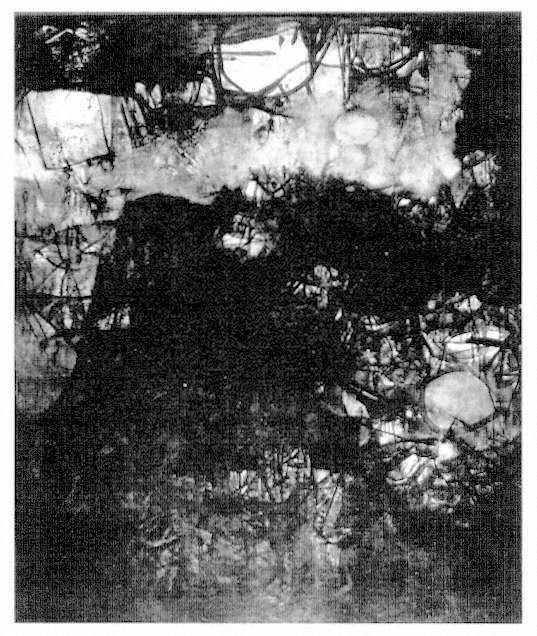
Figure 20
Edward Corbett, Untitled , ca. 1950-51. Oil and enamel
on canvas, 60 × 50 in. Collection of William M. Roth.
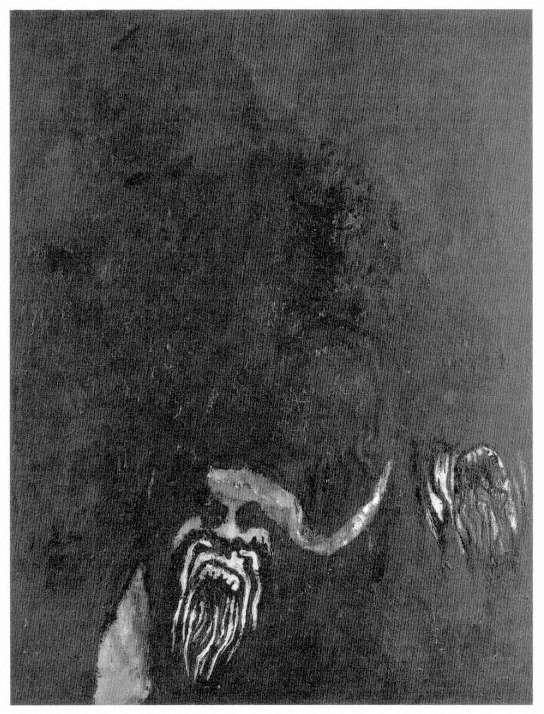
Figure 21
Opposite : Frank Lobdell, January, 1955 , 1955. Oil on canvas, 69 5/8 × 53½ in.
The Oakland Museum, gift of Mrs. Robert Chamberlain. Photograph by M. Lee Fatherree.
Museum's January, 1955 (Fig. 21), Lobdell's surfaces are as dry and parched as cinder. This painting evokes a fire-charred hell, the blackness pierced by flickering streaks of orange and red, suggesting flames as well as mouths open wide in agonizing screams. As we have seen, the cry of anguish was a theme that had earlier occupied Burkhardt, as it had Lebrun, Picasso, and Bacon. It is one of many war-engendered motifs—along with the crucifix, the savage beast, and the shadowy woods—that typify the painting of the period both in Europe and America, whether one looks to London, Paris, New York, Los Angeles, or San Francisco.
Conclusion
The years from 1941 to 1951 fundamentally transformed the art of California, no less than that of the country as a whole. In that decade, regionalism and other realist tendencies antagonistic to European influence gave way to a powerful tide of modernism that ultimately swept them off the stage entirely. New York is generally regarded as the generative site for this phenomenon, but in fact the trend toward abstraction was remarkably broad, apparent not only in galleries and studios in Manhattan, but in art schools and regional exhibitions across the country.[76] California's participation in the rise of modernism during the postwar era, then, should not be understood as a passive absorption of trends initiated elsewhere, but rather as a profound response to historical pressures brought about by the war. Although most of the strategies Californians found for expressing themselves had counterparts on the East Coast and in Europe, their art was by no means imitative or homogeneous. While it conformed to the categories of style found in other parts of the country—mostly surrealism, cubism, expressionism, and various admixtures—the range of expression was as varied as the population. Of interest here, however, as throughout much of the present volume, is not merely the concurrency of California modernism during the 1940S, but the question of its distinguishing characteristics. Was there anything singular about it that might be attributed to the physical and psychological environment?
Regionalism is a particularly complex issue for the period in question, because the very notion conflicts with the premise of internationalism that underlay modernist painting. And certainly modernism was never so zealous in crusading against cultural chauvinism as it was during the war years. To embrace the "international idiom of twentieth-century painting," as abstraction was commonly conceived then, was to con-
demn localism in art as well as politics. [77] As Mark Tobey remarked in 1946, the regional could be stressed only "at the expense of the inner world" and "the understanding of this single earth." [78] As different as their aesthetics were, Burkhardt, Spohn, and Lobdell would each doubtless have agreed with Robert Motherwell that "to fail to overcome one's initial environment is never to reach the human." [79]
Given this prevailing viewpoint, California modernists strove, not to emulate local traditions, but rather to transcend the particulars of time and place. Paradoxically, by reacting against indigenous conventions, Bay Area artists such as Corbett, Still, Smith, and Lobdell produced a kind of reactionary regionalism. During the late 1940S, they deliberately emptied their work of the bright, sunny colors associated with West Coast painting, notably the popular California watercolor school, which concentrated on western agrarian and coastal scenes. Los Angeles modernists also rejected local references. Burkhardt and Feitelson, McLaughlin and Lebrun—each sought a timeless, transcendent modernism that had little to do with the milieu of Southern California.
Yet in spite of the attempts to universalize, certain idiomatic traits took hold; certain strains of modernism became more prevalent in California than elsewhere. Abstract expressionism caught on more quickly in San Francisco than in other parts of the country, while Los Angeles became a center for figurative expressionism and hard-edge abstraction.[80] To some extent, these variations were due to the extraordinary force of individual personalities: Still's in San Francisco, Lebrun's and Feitelson's in Los Angeles. As the 1950s progressed, the differences between Northern and Southern California became ever more pronounced. By the 1960s the abstract classicism of Feitelson and McLaughlin had given birth to what became known as the L.A. look—Southern California's ultraslick, squeaky-clean variety of formalist abstraction. In Northern California an entirely different sensibility had taken hold: the determinedly individualistic, romantic antiformalism typified by the work of William Wiley, Joan Brown, and Robert Arneson. Ultimately, however, we must acknowledge that even if lineages can be traced to artists such as Still and Feitelson, a psychology of place, rather than the impress of a few innovators, encouraged the polarities of the 1960s and continues to inform the various regionalisms existing today.
Politics and Modernism:
The Trial of the Rincon Annex Murals
Gray Brechin
On the morning of May 1, 1953, the House Committee on Public Works convened in Washington, D.C., to debate the destruction of one of the largest and most expensive artworks ever commissioned by the federal government. [1] The artist Anton Refregier, according to Republican Representative Hubert Scudder of Sebastopol, California, had foisted upon the American taxpayer propaganda designed to slander the state's pioneers and convert patrons at San Francisco's main post office to communism. [2] In its daylong deliberations, the committee put history, as well as art, on trial.
Refregier was too modern, according to his accusers, for whom "modern art" was an imprecise but pejorative term covering form, or content, or both, as it served their purposes. Modern art was alternately incomprehensible and reprehensible, degenerate, or left-wing. Because they admitted at times that they were not sure just what it was, they felt safer saying what it was not ; modern art was not academic and thus did not support the social order and the state. In his subject matter, at least, Refregier had transgressed the official canon. [ 3]
To comprehend that day's strange events, one must understand not only the paranoia of the cold war but the near-Confucian reverence descendants of the California pioneers lavished on their ancestors. Ever since the Bear Flag Revolt of 1846 Anglo-Californians had envisioned their land as a mountain-walled principality, more nation than state. By California's fiftieth anniversary, in 1900, press and orators often compared the argonauts of 1849 to the founders of Rome. Artists were commissioned to pay them homage. In 1905 Daniel Burnham proposed a colossal monument for the summit of Telegraph Hill. For the 1915 world's fair, a permanent 850-foot Tower of the Pioneers was planned for Land's End. The tower was scrapped for lack of funds, but the exposition, as Secretary of the Interior Franklin Lane noted, was itself a monument to the superhuman valor and energy of the state's early settlers.
That the West was a place of unusual rapacity and violence and gold more a curse than blessing had been noted by visitors from the opening of the Gold Rush. The
banker William Tecumseh Sherman observed sourly in 1856 that "the very nature of the country begets speculation, extravagance, failures, and rascality." Frederick Law Olmsted told San Franciscans in 1866 that a great public park would help to "overcome the dead weight of indifference to all municipal improvements which is characteristic of the transient speculative class." Joshua Speed, a close friend of Abraham Lincoln, recorded while traveling in California in 1876 that money was the universal yardstick of worth: "They measure everything by the gold standard, men as well as mules. You never hear of Mr. Smith as a good man, or Mr. Brown as an honest man, or Mr. Jones as a Christian, but Mr. S has twenty thousand million and so on. The more he has, the better he is—and it matters not how he got it, so he has it." [4]
Such harsh judgments were drowned by the percussion and brass of official civic mythmaking. The industrialist Joseph Donohue Grant, son of a pioneer dry goods magnate, answered all would-be knockers in his 1931 autobiography. Of empire builders such as his father, he wrote:
Alert, high-spirited, warmhearted—those who constituted the population of early San Francisco were gentlemen adventurers outshining in brilliance similar coteries in older communities. What a libel to speak of a greed for gold bringing such men to California! They came as searchers after larger opportunities, to a new land abundantly rich because they made it so. No more openhanded people ever lived. [5]
In the heroic generosity, intelligence, and virility of the pioneers, Grant and his set found ample proof of the survival of the fittest and thus of their rightful place at the apex of the West's financial and social pyramid. In their traditional role as patrons, such aristocrats expected artists to reflect and support their certainty according to the academic tradition, in which history was depicted as a triumphal march undeterred by border skirmishes. Among a growing number of artists who rejected that tradition after the trauma of the Great War was Anton Refregier.
Although even the depression could not shake Grant's granitic confidence, the foundation myths crumbled for millions of Americans who suddenly found themselves near starvation in the Promised Land. By 1934 the socialist Upton Sinclair's grassroots campaign for governor had grown so serious that an unprecedented (and pioneering) smear campaign was required to defeat him and to elect the unpopular Frank Merriam in his place. [6] In the same year, conditions along the waterfronts of the West Coast grew so desperate that longshoremen walked out on what little work they had. Governor Merriam placed San Francisco under martial law and sent tanks to patrol the Embarcadero. The Pacific Maritime Strike culminated in a pitched battle in San Francisco between pickets and police (Fig. 22). Two workers were shot and killed in a fusillade at the foot of Rincon Hill. Within days, forty thousand men marched silently down Market Street (Fig. 23) in one of the largest funeral processions in city history. [7]
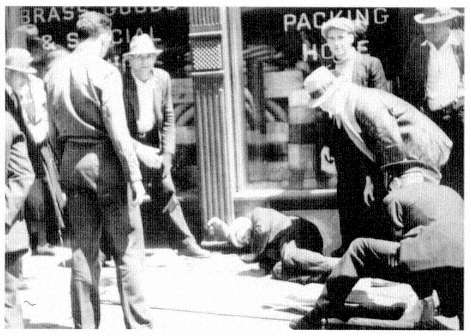
Figure 22
Unidentified striker, shot by police opposite the site
of the Rincon Annex Post Office, July 5, 1934. Photograph courtesy
San Francisco History Room, San Francisco Public Library.
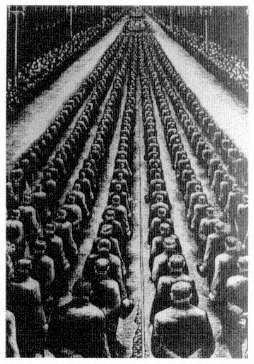
Figure 23
Left : Bits Hayden, Labor Buries
Its Dead , 1934. Lithograph.
The general strike that followed shut down the city for four days, precipitating a rain of phone calls and telegrams to Washington claiming that revolution had begun on the Pacific Coast. The alarms helped persuade President Roosevelt and his brain trust to accelerate their public works programs to short-circuit any such possibility. No one has ever inventoried the New Deal's legacy of public works for the Bay Area alone, but it would include paved roads, sewers, forests, parks, schools, and theaters, as well as a myriad of federal art projects. [ 8]
Prior to the crash, virtually all public art had endorsed the benignity and legitimacy of the American Dream. No market existed for artists who might question it. But in 1934, in the depth of the depression, President Franklin Roosevelt opened a window for those who might dissent, giving them both patronage and exhibition space without precedent in the United States.
Roosevelt's experiment in federal art sponsorship began at the suggestion of his Groton and Harvard classmate George Biddle. A painter himself, Biddle first proposed to the president in 1933 that the government provide relief for American artists. Biddle hoped to create the seedbed for an American renaissance. He later wrote of the Works Progress Administration Federal Art Project: "Its credo is that if one creates a cultural background, art will follow. It wasn't Michelangelo who created the 15th century but the 15th century that created Michelangelo." [9] The conservative Commission of Fine Arts, created by Congress in 1910 to advise the government on artistic matters, recommended against Biddle's proposal in a report to the president, fearing trouble from modern muralists who professed "a general faith which the public does not share," one that ignored "the established tradition . . . fostered by the American Academy at Rome." [ 10]
The Public Works of Art Project (PWAP) and the other programs that followed it initiated controversies that outlived Roosevelt by many years as a minority of left-wing artists tested the First Amendment and reactionaries, in turn, cited the right of taxpayers not to be insulted or indoctrinated by "radicals." Guardians of tradition and morality like the National Society for Sanity in Art, founded by the Chicago socialite Josephine Hancock Logan, along with its regional affiliates and the Hearst press, carefully scrutinized the new public art for symptoms of modernist "decadence" or the un-American content usually equated with it. [11]
The federal art projects never received the popular support Roosevelt himself enjoyed. The president created them by executive fiat, leaving representatives to deal with their irate constituents. [12] Nor did Biddle help. The aristocratic artist enjoyed needling powerful domestic opponents: "The most serious threat to the success of life of the Project," he wrote after much experience, "is the high emotional level and the low mental caliber of our Congressmen." [13]
Biddle looked to Mexico for a model of government art patronage, but in doing so he ignored the radically different political climate of the neighboring nation. By 1934 privately commissioned works by two Mexican muralists had amply demonstrated the
uproar that allegedly subversive subject matter could cause in the United States. In 1930 José Clemente Orozco completed his mural Prometheus in the Pomona College dining hall, despite vigorous attacks from college trustees and local newspapers alarmed by what they perceived as their revolutionary content. Four years later, Nelson Rockefeller ordered stripped from the lobby at Rockefeller Center Diego Rivera's mural Man at the Crossroads , whose numerous unorthodoxies included a portrait of Lenin as well as syphilis spirochetes swimming toward a swank dinner party in what was intended to be a cathedral of capitalism.
On an extended visit to paint murals in San Francisco during the early 1930s, Rivera had strongly influenced many of the artists whom the government would later commission to decorate the walls of the new Colt Memorial Tower on Telegraph Hill. Edward Bruce, head of the PWAP, hoped that the tower's murals would serve as a pilot demonstration of how federal patronage could enrich the nation's cultural life. Their theme was "Aspects of Life in California, 1934"—a bad year, as it turned out, for officially sanctioned subject matter. [14]
In mid-February, the San Francisco Artists' and Writers' Union met at the unfinished tower to protest "the outrageous vandalism and political bigotry" represented by the destruction of Rivera's New York mural. Their activism only drew attention to what they themselves were creating. Reporters from the major press quickly discovered subtle heresies in the tower's murals meant to undermine the national faith. In a large street scene, for example, Victor Arnautoff had replaced the San Francisco Chronicle with the Daily Worker and the Masses . Browsers in Bernard Zakheim's Library were choosing Das Kapital rather than The Wealth of Nations . Worst of all, Clifford Wight had included, without permission from the regional PWAP chairman, Dr. Walter Heil, a hammer and sickle as emblematic of one economic choice available to Americans in the 1930s.
In his capacity as director of the M. H. de Young Memorial Museum, Hell was unaccustomed to the controversies of art in action. He wired Washington that "editors of influential newspapers . . . have warned us they would take [a] hostile attitude towards [the] whole project unless these details be removed." Edward Bruce responded that he hoped the artists "don't fool around with this Socialistic thing any longer," and advised Hell to "wipe the damn painting out of the Tower." [15] Making good on its promise to Heil, the Hearst-owned San Francisco Examiner carried a nationally syndicated photograph of Wight's symbol crudely spliced onto Zakheim's Library . [16] The doctored photo appeared on July 5, 1934, the day the strikers were killed at Rincon Hill. So intense did the controversy become, and so closely linked was it to the events on the waterfront below Telegraph Hill, that the city Park Commission ordered Coit Tower locked, ostensibly to prevent vandalism. It was reopened on October 20, 1934, after passions had cooled. By that time, Wight's symbol had mysteriously vanished.
Evelyn Seeley, reporting on the Coit controversy, felt it was a tempest in a teapot. "In the main, [the artists] presented California as powerful and productive, its machines
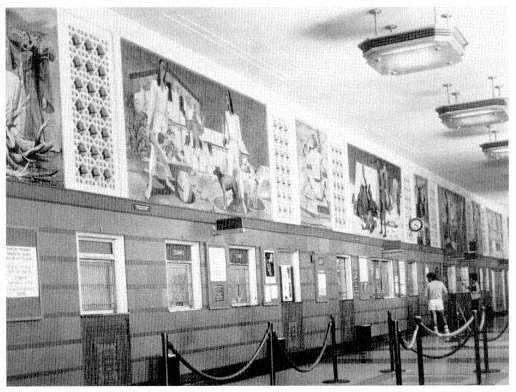
Figure 24
Rincon Annex lobby with Refregier murals. Photograph courtesy
San Francisco History Room, San Francisco Public Library.
well-oiled, its fields and orchards bountiful, its people happy in the sun." In a comment prophetic of those made in the thick of the Rincon Annex controversy, she added, "They have left out of the picture, as some realists have mentioned, such aspects as the Mooney case, or strikes or lynchings." [17]
The Colt Tower controversy did not end government patronage. Rather, New Deal programs proliferated in the years that followed. Of the art bureaucracies that followed the PWAP, the Treasury Section of Painting and Sculpture (known simply as the Section) offered the most prestigious and lucrative prize. [18] Created by executive order of Treasury Secretary Henry Morgenthau on October 14, 1934, the Section would ensure high-caliber work in public buildings by selecting artists in juried competitions. In 1940 a Section jury chose Anton Refregier, of Woodstock, New York, from among eighty-two contestants, to decorate a new post office in San Francisco (Fig. 24). The government agreed to pay Refregier $26,000 to design and paint a chronological history of
the city in twenty-seven panels totaling 2,574 square feet. A delighted Refregier told reporters that he had worked five solid months preparing his designs. What he did not tell them was that he would paint just those "realist" subjects that Evelyn Seeley said had been left out of Coit Tower.
A strong-minded outsider, Refregier also told the Chronicle when he arrived in San Francisco that he wanted to paint the past, not as a romantic backdrop, but as part of the living present, a present shaped by the trauma of depression, strikes, and impending war. He did not, he added, believe that the miners of 1849 wore gardenias, and he saw no reason to paint them as if they did. [19] In these desires and beliefs Refregier was modern, differing sharply from both working-class patriots and ancestor-proud patricians such as Joseph Donohue Grant. World War II, however, interrupted the Rincon Annex project, while Roosevelt's death virtually ended the brief experiment in federal patronage. By the time Refregier returned to San Francisco in 1946, the Section was being phased out and responsibility for its outstanding projects transferred to the Public Buildings Administration.
Refregier's highly ambitious program was traditional enough. He envisioned representing the entire span of human civilization in the brief history of San Francisco. In the cycle as originally conceived in 1940, the artist had intended to begin with a California Indian creating a primitive work of art and to proceed through a sequence of conflicts to the 1939 Treasure Island world's fair celebrating peace in the Pacific. Following the armistice, he changed the last panel to a three-part composition representing the war, the Four Freedoms, and the founding of the United Nations. Refregier had covered the latter event in San Francisco for Fortune magazine.
Controversy began before the Rincon paintings were finished (Fig. 25). [20] The Catholic Church protested that a friar preaching to Indians at Mission Dolores was too fat; Refregier slimmed him. In 1947 the Public Buildings Administration ordered Refregier to take President Roosevelt out of his panel The Four Freedoms . The artist claimed that a Republican Congress had initiated a campaign to discredit the late president and the legacy of his New Deal. [21] Although he called on the people of San Francisco to support his refusal to carry out the order, he eventually complied. [22] His troubles had only begun.
By the spring of 1948 the Veterans of Foreign Wars were protesting Refregier's depiction of the maritime strike and the funeral for the strikers killed across the street from the Rincon Annex Post Office. Fourteen years after the strike and killings, those events were still raw in local memory. According to the VFW, the strike leader rallying massed workers in Refregier's painting appeared to be the suspected communist Harry Bridges (Fig. 26). He points accusingly at a hiring boss taking bribes in the notorious "shape-up system" that prevailed before the strike won longshoremen the right to a union hiring hall. [ 23] The artist may as well have tossed gasoline onto a guttering campfire. "The stories in the Hearst press," he later wrote, "brought out gangs of hoodlums who were constantly under my scaffolding and I no longer worked after the sun set." [24]
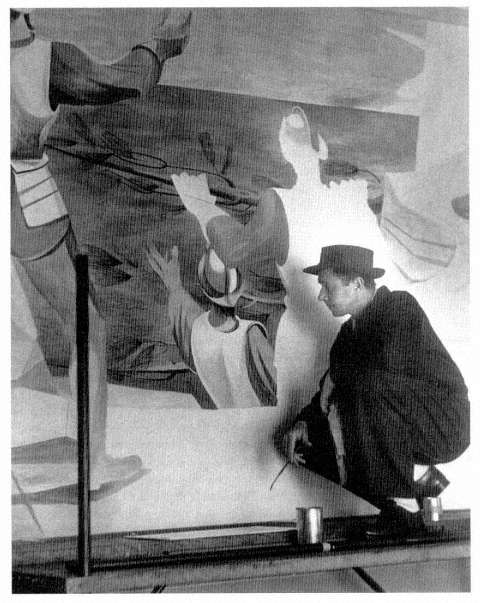
Figure 25
Anton Refregier painting a mural in the Rincon Annex Post Office. Photograph
courtesy Labor Archives and Research Center, San Francisco State University.
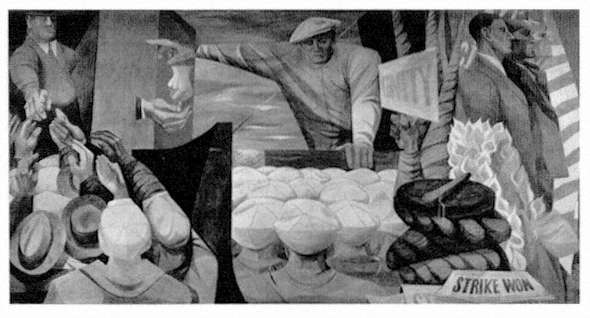
Figure 26
Anton Refregier, The Waterfront —1934 . Refregier's controversial pro-labor mural. The panel, based on an
Otto Hahn photograph, shows men, at left, begging for jobs from a corrupt hiring boss. The figure at center
could be Harry Bridges organizing the union, and the figures at right mourn two strikers killed by police on
"Bloody Thursday," July 5, 1934, the day the police fired at strikers on Rincon Hill.
Despite a national outcry by artists and labor unions, the Public Buildings Administration ordered the offending panel covered until specified changes were made. Refregier wrote that "it was a most telling coincidence that on the day the men came to cover up this panel, I was at work on a mural depicting the burning of the books by the Nazis. [25] He told the People's World that "this attack is clearly a part of the whole thought control campaign" to censor history. [26] The artist was supported by the Congress of Industrial Organizations and the International Longshoremen's and Warehousemen's Union, which denounced the "Hearst-inspired attempt to suppress the work of art." [27] In Refregier's paintings, instead of the standard vindication of the status quo, union members found the theme of class struggle. On May 14, 1948, they joined artists in a picket line at Rincon Annex to defend the murals (Fig. 27).
When the painting was unveiled with minor changes, the Grand Parlor of the Native Sons of the Golden West declared itself unmollified. The attorney Waldo Postel announced that the NSGW would scrutinize the artist's background as well as the
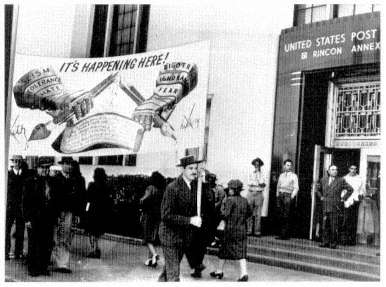
Figure 27
Artists and union workers picket to protest modifications
demanded by the Public Buildings Administration in the
Rincon Annex murals, May 14, 1948. Photograph courtesy
San Francisco History Room, San Francisco Public Library.
"Marxian interpretation" of the entire cycle. True to his word, Postel analyzed Re-fregier's work closely and noted numerous transgressions. He accused the artist, for example, of "memorializing the Federal Art Program of 1932-41 [in the panel Cultural Life ], although what connection it had with San Francisco's cultural history I don't know." [28]
Refregier's murals elicited enmity in high places. On July 18, 1949, Representative Richard Nixon of California responded to a concerned American Legionnaire:
As to whether anything can be done about the removal of Communist art in your Federal Building [Rincon Annex] . . . at such time as we may have a change in administration and a majority in Congress, I believe a committee should make a thorough investigation of this type of art in government buildings with the view to obtaining the removal of all that is found to be inconsistent with American ideals and principles. [29]
As cold war paranoia grew, so too did a passionate debate over what some felt to be subversive themes concealed in public art sponsored by the Roosevelt administration. Michigan Representative George Dondero, in particular, launched a campaign against all that was "modern" in art, a term which he defined as "communistic because it is distorted and ugly, because it does not glorify our beautiful country, our cheerful and smiling people." [30]
The Republican Party in 1953 took control of both the White House and the Capitol. With Richard Nixon as vice president and Representative Dondero as chairman of
the House Committee on Public Works, Congress prepared to undo the New Deal and to roll back the red tide of modernism in Nixon's home state. [31] Anton Refregier's murals were the first works to be tried for themes "inconsistent with American ideals and principles."
Representative Scudder opened the hearing by telling his committee that Refregier had been born in Moscow and that his office had been flooded with complaints from the American Legion, Daughters of the American Revolution, Veterans of Foreign Wars, the Sailors' Union of the Pacific, and other patriotic organizations. The Young Democrats of San Francisco charged the murals with being "little short of treason." The Society of Western Artists, a regional affiliate of Logan's Sanity in Art, [32] declared them "artistically bad, historically absurd, and politically corrupt." A letter from the California Department of the American Legion expressed its members' concern that the murals would expose thousands of school children who toured the facility to scenes that unfairly depicted what it believed was "the true history of our State."
The operative statement that recurred, verbatim, in nearly every protest that Scudder read into the Congressional Record was that "said murals do not truly depict the romance and glory of early California history, but on the contrary cast a most derogatory and improper reflection upon the character of the pioneers, and the other murals are definitely subversive and designed to spread communistic propaganda and tend to promote racial hatred and class warfare " (emphasis added). [33]
Scudder then yielded the floor to California Representative Donald L. Jackson, who insisted that his testimony "should not be construed as representing the results of an investigation" by the House Un-American Activities Committee (HUAC), of which he was a member. Jackson's seven-page account of Anton Refregier's participation in communist front and peace organizations took forty-five minutes to read. The painter, he said, had defended such fellow travelers as Dalton Trumbo, Pablo Neruda, Harry Bridges, and the Rosenbergs and, as a member of the suspect American Peace Crusade, had once given a reception to honor the Los Angeles painter Charles White, "a Negro artist." [34] He had taught at the John Reed School in New York and the California Labor School in San Francisco. [35] The list went on.
Under questioning by Chairman James C. Auchincloss, Congressman Jackson admitted he had not seen the San Francisco murals but asserted, "If they were in the Capitol of the United States, I would join in protesting them." When Scudder revealed that Refregier had won the Section competition because of favorable votes from the artists Victor Arnautoff and Arnold Blanch, Jackson read their HUAC dossiers into the Record . Philip Guston had favored another entry and was spared embarrassment. [36]
Congressman Scudder then detailed, panel by panel, what he found objectionable in Refregier's cycle. [ 37] California Indians were depicted as vigorous and strong, the Spanish and English explorers as warlike and conquering. The monks building Mission Dolores appeared cadaverous in one panel and big-bellied in the next, where their In-
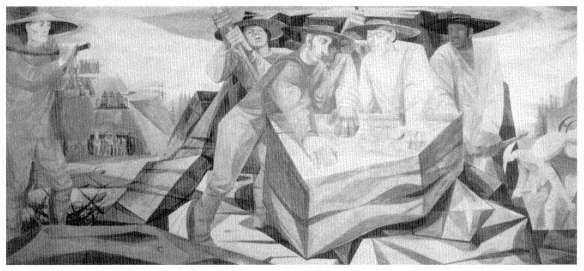
Figure 28
Above : Anton Refregier, Budding the Railroad Representative Scudder
protested that the mural's portrayal of the Chinese workers "would give
he impression that they were brought over more as slave laborers than anything else."
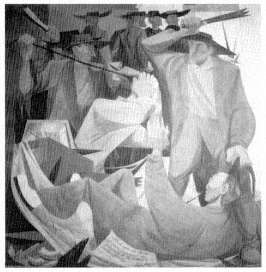
Figure 29
Right Anton Refregier, Sand Lot Riots . Represen-
tative Scudder objected that the scene was not
realistic, nor did it "represent the development
of the Golden West."
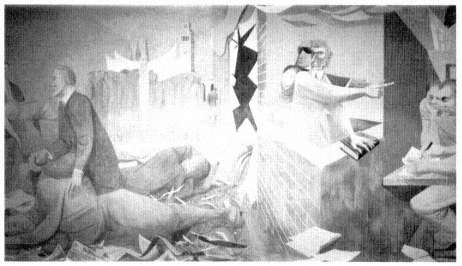
Figure 30
Opposite: Anton Refregier, Preparedness Day Bombing and Mooney Trial .
Perjured jurors, right of center, accuse Mooney and Billings, at far right.
dian wards appeared to be starving. The pioneers on The Overland Trail also appeared "cadaverous and soulless." In Discovery of Gold , the miners seemed to thank God for the metal they had found, suggesting that Californians were materialists, as the communists claimed. In the panel showing the building of the transcontinental railroad (Fig. 28), Scudder thought Refregier was saying that the Chinese had done most of the work—which was, in fact, common knowledge in California.
In a dark corner, Refregier had painted two riots. Scudder felt that The Civil War unnecessarily depicted regional strife in a public building. In the adjacent Sand Lot Riots (Fig. 29), Refregier had shown Irish laborers beating the Chinese. Scudder protested, "I do not believe that this ugly scene had a bearing on the development of California. . . . If it did happen, it is similar to the riots that happen every day in some country." Furthermore, the congressman complained, the rioters were sporting "peculiar clothes and funny hats which were not commonly worn in the days of early California." He felt that the depiction of the 1906 earthquake unnecessarily aggrandized tragedy and implied that it took a great disaster to make Americans work together.
Scudder inexplicably paid little attention to one panel that conflated the mysterious bombing of a Preparedness Day parade in 1916 with the perjured testimony of witnesses that subsequently sent labor leaders Tom Mooney and Warren Billings to prison for the crime (Fig. 30). His omission was curious, for the Mooney trial had provoked an international furor and long served as a flash point in confrontations between conservatives and liberals. Scudder moved on, instead, to the panel that had begun the brouhaha. The Waterfront —1934 showed "strikes and various other disturbances" that were not, the congressman charged, "the things that make California great." Nor did the men in the next panel, which showed the building the Golden Gate Bridge, resemble those
he had observed at work on the structure. Scudder also repeated the allegation of the Hearst newspapers that Refregier had included in The Four Freedoms a figure resembling Gilbert Stanley Underwood—the architect of the post office—with "long mule ears."
Scudder's final criticism was demonstrably mistaken on three points: the controversial figure was not Underwood, it occupied the adjacent United Nations panel, and the suspect "ears" were, in fact, a garland of laurel leaves Refregier had seen decorating the stage when he covered the signing of the U.N. charter for Fortune magazine. Scudder's confusion suggested that he, like Representative Jackson, had never seen the murals that he sought to have destroyed.[38] He summed up by saying,
There seems to be nothing in these pictures that would be anything but depressing. I do not believe that one of the murals conveys a smile, or the indication of a smile, or contentment, or encouragement. What the artist was endeavoring to convey is beyond me, except that we are unemotional and unsympathetic in the development of the State of California and the building of the West.
The attack on the murals continued after the lunch break when Fred Drexler, a retired newspaper reporter, testified that a postal worker at Rincon Annex had told him that "the Government ought to increase his pay to make up for his suffering in seeing these murals." Gordon A. Lyons, the department adjutant of the American Legion of California, submitted more demands for the removal of the murals, from organizations ranging from the Associated Farmers of California to the South of Market Boys Association. The discerning eye of the attorney Waldo Postel had meanwhile discovered heresies in The Four Freedoms more subtle and dangerous than Refregier's tribute to the New Deal art projects; Postel informed the committee that "the head of the family there shown wears a red tie, while the boy reads a large red-covered book. The predominating color in these three panels is red." He concluded: "These murals are definitely subversive and designed to spread communistic propaganda."
Late in the afternoon Congressman John Shelley of San Francisco rose to rebut his colleague from Sebastopol. As he spoke, Shelley—who was to be elected mayor of the city in 1964—gradually established his bona fides. He was a descendant of Irish pioneers, his father was a longshoreman, he himself was a member in good standing of the Native Sons of the Golden West, with which, he added, he respectfully disagreed on this one issue. He was also active in the labor movement. His grandfather, he said, like most California men of the time, had worn one of the "funny hats" to which Scudder had objected. Moreover, as a Catholic, Shelley found nothing objectionable in Refregier's paintings, nor did any prelate that he knew. Similarly, he could testify to the reality of the waterfront shape-ups and the payoffs to corrupt gang bosses. Shelley believed that mature citizens of a democracy were entitled to see and hear provocative subject
matter: "The cold factual portrayal of history . . . may be pleasing to some and repugnant to others, but if it is factual you cannot change history or a picture of history or a portrayal of it by saying 'But I do not like that.' If we get into that, Mr. Chairman, then we are definitely contributing to thought control and trying to build a Nation of conformists."
Scudder riposted that Refregier could have shown the grape industry, stock raising, or industrial development: "We know the history of the world has not always been sweet, but I do feel that we should glorify the best in life." Shelley shot back, "Mr. Scudder, I do not wish to argue with you about it, but I can certainly appreciate your feeling about wishing to portray the sweet things, because by nature you are so sweet and generous yourself."
Congressman William Maillard, scion of an old San Francisco family, took the stand next. Whereas Shelley had spoken for labor, Maillard spoke for the patriciate. He informed the committee that the Chronicle's art critic, Alfred Frankenstein, supported the murals, as did the principal art associations and museums and their boards of directors, "who are among our most highly respected and responsible citizens." When Congressman Will E. Neal asked him, "What percentage of the people who view these paintings today would be inspired in any way whatsoever to become sympathetic to communistic ideas?" Maillard replied, "I should think none at all." Tensions were running high in the hearing room; when Congressman Harry McGregor of Ohio ventured, "I do not think it is art, but I am no artist," Maillard rejoined, "A great many people will agree with you about that."
By the end of the afternoon, a procession of distinguished witnesses had spoken or provided written testimony in favor of the San Francisco paintings. The respected antiquarian bookseller Warren Howell countered charges that Refregier's murals were "historically absurd" by insisting they were not only truthful but based on careful research. Refregier had done his homework. The attorney Chauncey McKeever said that the proper judges should be, "not Legion posts, not marching and chowder clubs, but experts." John Hay Whitney, chairman of the New York Museum of Modern Art's governing board, wrote on behalf of the murals. So did the Artists Equity Association. Congressman Scudder read into the Record a statement revealing the communist sympathies of Equity's founders.
When Hudson Walker of Artists Equity attempted to read a letter from the eminent British scientist and former director of UNESCO Julian Huxley, Congressman McGregor ordered it struck from the Record . McGregor did not like, he said, "to have people from Great Britain putting things in a hearing and making statements like that against a Member of Congress when the person making the statements is not here to answer a few questions that we would like to ask him. Certainly our colleague [Scudder] is a good American and believes in law and order and is a defender of American freedom."[39] In the official Record seven asterisks accordingly replaced Huxley's letter.
Fortunately, Huxley's letter to Refregier was preserved in the National Archives.[40]
Huxley commended the artist for a "remarkable work of art and an outstanding example of modern American painting." He and the officials at UNESCO were alarmed, he said, "by the growing tendency in your country to try to exert political control over freedom of thought and expression." The lamentable state of biology and philosophy and the arts in Stalin's USSR "shows what happens when creative thought and expression is subjected to control on political or ideological grounds." Huxley thought it ironic that even as the free world was protesting tyranny in the Iron Curtain countries, "actions like that of Representative Scudder are trying to introduce a similar tyranny into your own great country." It was apparently this last statement that provoked Congressman McGregor to have Huxley's letter deleted, for what made Refregier's art so dangerously "modern" to his critics was precisely its dissent from official mythology.
The directors of all three San Francisco museums entered their protests in turn.[41] Thomas Carr Howe, director of the California Palace of the Legion of Honor, defended the murals and called Scudder's resolution "a shameful measure, in its essence, vandalism." He told the committee that "the three great art museums of San Francisco are solidly against this resolution and the two leading historical societies have not seen fit to support this resolution in any way."[42] Asked by Representative Tom Steed to tell the committee what made him an expert, Howe replied that he had received his doctorate from Harvard. He added that his great-grandfather had arrived in California in 1848, placing him decisively among the state's ancien régime.
Howe's pedigree mattered, for photographs of one mural troubled congressmen sufficiently to engage the director in lengthy cross-examination over a historical detail. The dark neck of a figure about to be lynched by vigilantes (Fig. 31) strongly suggested to Representative Gordon Scherer of Ohio that the man was a Negro, but since "there were none in California during the vigilante days," added Myron George of Kansas, critics saw in the neck yet another indication of the artist's subversive intentions. When Hubert Scudder noticed that Refregier was not present to clarify the point, his attorney replied that the artist was too busy painting a synagogue to attend. The congressmen were doubly mistaken, for blacks had, in fact, come with the Gold Rush, but the suspicious figure was clearly not one of them.
Grace L. McCann Morley, director of the San Francisco Museum of Art (later the San Francisco Museum of Modern Art), sent written testimony ranking Refregier's murals "high among the distinguished American murals of recent years." Though she lacked Howe's pedigree, Morley assured the committee that "as a second generation Californian . . . I find nothing derogatory nor offensive in the subject matter, and there is no evidence of subversive symbolism or reference."[43]
At the hearing's close, attorney Chauncey McKeever inserted into the Record the names of hundreds of citizens who protested the Scudder resolution, among them many of San Francisco's business and professional leaders and philanthropists. Three days after the hearing, the president of the San Francisco Chamber of Commerce, J. W Maillard III, cabled his son, Congressman W. S. Maillard, denying Scudder's claim that
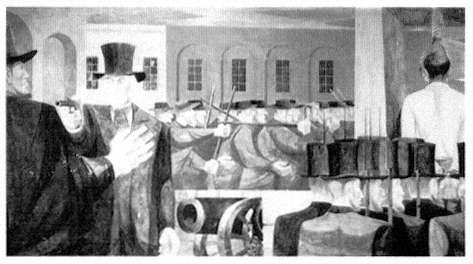
Figure 31
Anton Refregier, Vigilante Days . Representatives Scherer and
George suspected that the man being lynched was a "Negro."
his organization supported the resolution. His telegram was inserted into the Record .
Five weeks after the congressional hearing, the California Senate voted overwhelmingly to urge Congress to destroy the Rincon murals.[44] The Hearst-owned Examiner recommended their removal if "loyal American citizens" found them subversive.[45] Nevertheless, Scudder's motion never made it out of committee. The murals stayed.
The figures Congressman Scudder saw as "cadaverous and soulless" were, in fact, painted in Refregier's own distinctive style. They may well have been his reaction to the plump pink shepherds in the fake Bouchers and speakeasy murals he and Willem de Kooning had painted for an interior decorator prior to the crash.[46] Congressman George Dondero had already attacked Refregier's lanky figures as examples of "so-called modern art." Representative Myron George of Kansas, like others, was disturbed by Refregier's angular style and said that "in viewing the picture I cannot get over the distortion of the people of that early period, even those of California." Representative Scherer explained, "It is modern art."[47]
The federal art projects never, in fact, encouraged abstraction in public places; Edward Bruce and the Section of Fine Arts advocated a "middle course" in which abstraction had as little place as social protest. Though Refregier's figures and backgrounds were stylized, they were easily recognizable. Far more genuinely modern than Refregier's paintings was Hilaire Hiler's surreal and stylized submarine panorama in San Francisco's Aquatic Park casino, built by the Works Progress Administration (WPA); Hiler's
art elicited none of the outrage caused by the Coit Tower and Rincon Annex murals and was even admired by the conservative San Francisco Chronicle and Time magazine.[48] However "modern" in form, the Aquatic Park murals had no modern political content.
Though he had studied with Hans Hofmann, Anton Refregier had little sympathy for nonfigurative art in communal places. To educate a broad public, he had to communicate with it.[49] What he had to say and the place where he said it provoked the unprecedented hearings in Washington.
But if he eschewed a modern style, Refregier also vowed not to paint official subject matter. "We rejected long ago, while on the Federal arts projects," he wrote to the Chronicle's art critic, Alfred Frankenstein, in 1952, "the meaningless type of mural painting where the pioneer dressed in Hollywood fashions, shaven and manicured, would be briskly walking along guided by a 'spirit' of one thing or another, its Grecian garments floating in the wind. This concept pays disrespect to the vitality, power, and labor of those who came before us."[50] Refregier expressed that vitality in two riots, a terrorist bombing, a lynching, several murders, a frame-up, a landgrab, an earthquake, and a world war—not normal fare for a federal post office. In Refregier's gritty, if stylized, realism, Scudder and his colleagues were right to sense danger to received wisdom. In content, rather than in style, Refregier was too "modern."
It is hardly surprising, then, that Scudder first objected to Refregier's depiction of the California Indians as strong and vigorous before the white man's advent. Textbooks and public art had long taught Californians that nature had fated the original inhabitants of their state to vanish before the superior races, and that natives carried little significance except as symbols of brutish humanity from which civilization had risen. Most New Deal art perpetuated the progressive conventions inherited from academic painters such as Arthur Mathews, who in 1914 had painted a mural cycle in the California State Capitol strikingly different from Refregier's (Fig. 32).
In Sacramento, Mathews had depicted Indians living in childlike innocence until kindly padres arrived to teach them to work. Allegories of Victory and Civilization then led consecutive waves of immigrants past sidelined Indians toward a city of the future, a new Athens on Pacific shores, where Anglo-Saxon maidens dance in flowery meadows.[51] What Mathews expressed visually, the novelist Gertrude Atherton reiterated in a popular history of the state: "Month after month, year after year, [Father Junipero Serra] traveled over these terrible roads . . . making sure that his idle, thieving, stupid, but affectionate Indians would pass the portals of heaven."[52]
Refregier was well aware of how and why the Indians had passed heavens portals suddenly, in large numbers, but he censored himself: "Obviously, I could not go into this and get away with it," he wrote. His own cycle begins instead with a California Indian creating art, a sign of intelligence inevitably denied him by the conquerors followed in the next panel by a mother cradling her child.
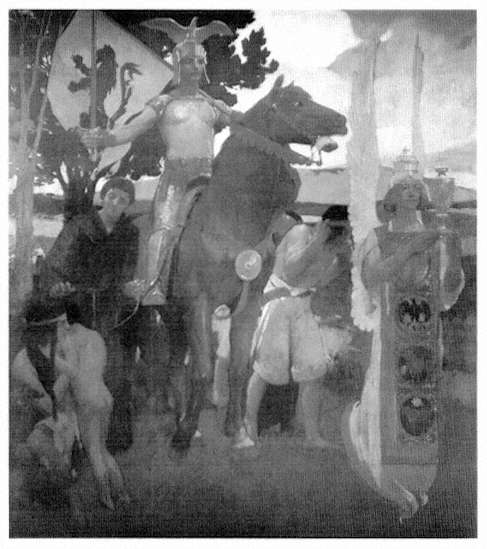
Figure 32
Arthur Mathews, Adventure , 1914. California history cycle, rotunda of the State Capitol,
Sacramento. Allegories of Civilization and Victory enter California, while missionary friars
Christianize Native Americans and teach them how to work. Photograph courtesy Histori-
cal State Capitol Commission, California State Capitol.
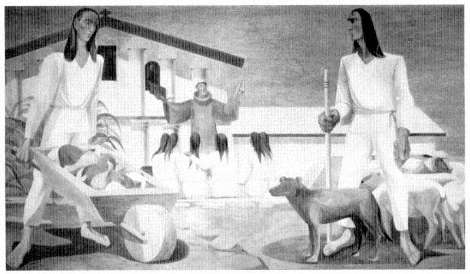
Figure 33
Anton Refregier, Preaching and Farming at Mission Dolores .
Refregier gave the Native American laborers at the mission a prominence
and dignity rare in public art. He was ordered to slim down the friar.
That Refregier showed two Indians as strong and dignified workers, standing in the foreground of Mission Dolores with the friar in the background was in itself extraordinary (Fig. 33). Though sympathetic to Refregier, Congressman Shelley had trouble understanding what the artist intended. Answering Scudder's charge that the Indians were excessively vigorous, Shelley said that he did not know whether the Indians were strong, muscular, and sinewy but "had always heard that they were very lazy people who were not taken over much by conquest because very little conquest was needed."[53]
Refregier's depiction of California's natives was only the beginning of the remarkable and subtle shift in emphasis he gave San Francisco history. Although his accusers repeatedly charged him with promoting racial hatred, Refregier, throughout his cycle, depicted people of all races working, and occasionally fighting, to build the city. Twenty-six panels formed the prologue to the last, a triptych depicting the catastrophic consequences of racial and national hatreds in the Second World War, Roosevelt's declaration of the Four Freedoms, and men and women of all nations and races sitting together at a round table to guarantee those freedoms.
Perhaps only an outsider could have shown local history with such breadth, depth, and empathy. As Warren Howell and others testified, Refregier knew San Francisco history better than his accusers. He had, furthermore, endowed it with universality. In his complex depiction of "the vitality, power, and labor of those who came before us,"[54] he had painfully pricked the myth of civilizations harmonious forward march. The
hearing in Washington had put history, as well as art, on trial, and had shown how inseparable they were in the minds of Refregier's conservative critics.
Shortly after completing the cycle, during the heightened controversy over his murals, the artist noted his fears for what he considered his masterpiece: "Some night, perhaps, men will come with buckets of white paint and it will take very little time to destroy that which took me so long to make. And in the morning it will be just like it was three years ago. White walls without colors, without ideas, ideas that make some people so mad and so afraid."[55]
As it turned out, the passage of time would make vandalism unnecessary.
Despite allegations that the murals promoted class warfare, San Francisco's elite in fact rallied to save them. Certainly, that support was based on principle: to destroy nonconforming art would have been a most un-American activity, one unworthy of San Francisco's claim to be the cultural center of the Far West. But the city's leaders were also too sophisticated to see any real threat to the foundations of American institutions in Refregier's art. Thomas Carr Howe testified that his colleague at the de Young Museum, Dr. Walter Heil, had watched while as many as eight hundred people used the post office. "Not one person," Heil said regretfully, "even looked at the murals."[56]
In 1979 artists and preservationists, led by Refregier's friend Emmy Lou Packard, rallied once more to save his murals when the postal service abandoned its building.[57] Today, the Rincon Annex lobby is a designated city landmark. It serves as the foyer to an upscale mixed-use office complex called Rincon Center. The murals were restored in 1987 by Thomas Portué
Of the hundreds who pass through it, few pause to look at the paintings that once provoked such heated debate. Fewer still can identify the incendiary events—the waterfront strike, the Mooney trial, or the Sand Lot Riots—and almost no one, except a few aging union members, visits the Longshoremen's Monument across the street where two men were killed in 1934. In Rincon Center's soaring atrium, office workers lunch around a dramatic forty-foot water curtain, below trompe-l'oeil murals created during the Reagan years by the New York artist Richard Haas.[58] Painted to resemble a pastel bas-relief, those murals depict scenes of agricultural abundance, industrial harmony, and financial success. In both style and content, Haas's murals are as much pre- as post-modern. They are exactly what Hubert Scudder said he wanted.